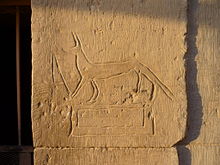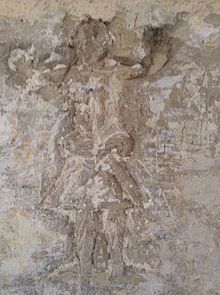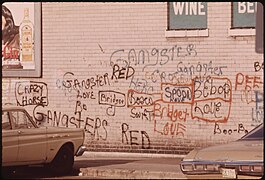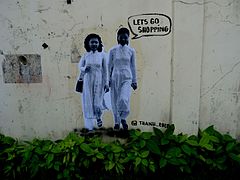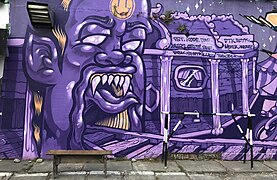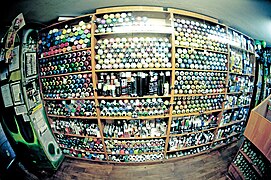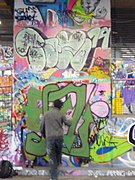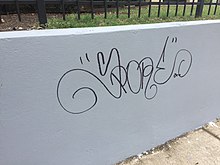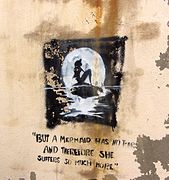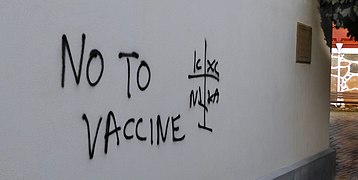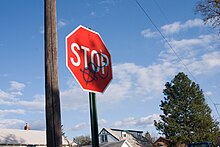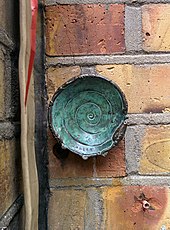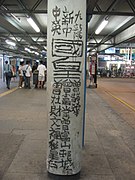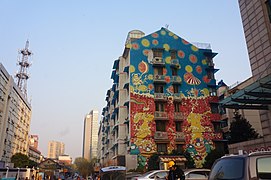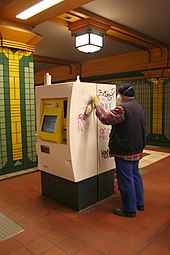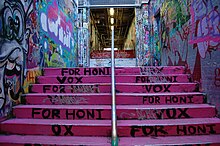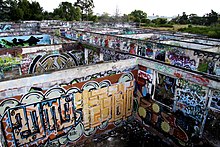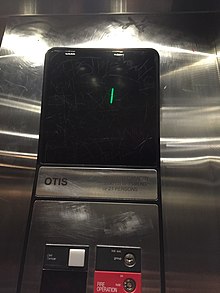Муниципальное Автономное Образовательное Учреждение лицей №7 г.Томска
Проектная работа
по английскому языку
«Граффити-искусство или хулиганство»
«Graffiti-art or vandalism»
Работу выполнили ученики 7А класса: Асаев Роман, Кузькин Роман, Сорокин Роман.
Куратор работы: учитель английского языка Лазарева С.В.
Томск 2013
Contents
Introduction………………………………………………………………………………3
History of Graffiti……………………………………………………………………..4
Types and styles ………………………………………..……………………………..5
Art or Vandalism……………………………………………………………………….7
The survey ………………………………………………………………………………….8
Conclusion ………………..……………………………………………………………….9
Internet sources ……….…………………………………………………………………10
Enclosure №1 Questions for survey “Graffiti-art or vandalism.” ……………………11
The aim of the project work: learn and sum up information about graffiti, exploring the pictures of graffiti and teenagers’ relation to them.
Цель проектной работы: изучение и обобщение знаний о граффити, а так же исследование рисунков граффити и отношение к ним учащихся нашей школы.
Project problems:
Learn the history and developing of graffiti;
Explore the different types of graffiti;
Find out the teens’ attitude to this kindof modern art;
Write and draw own pictures.
Задачи проекта:
Проследить историю возникновения и развития граффити;
Изучить разные виды граффити ;
Исследовать отношение подростков к этому виду современного искусства;
Создать свои рисунки и надписи в стиле граффити.
Suppose: not all pictures and words on the fences and walls are the objects of art.
Гипотеза: Предположим, что не все рисунки на стенах и заборах являются объектом искусства.
Graffiti- is writing or drawings scribbled, scratched, or sprayed illicitly on a wall or other surface in a public place. An usual artist uses paper and canvas for his work, but graffiti artists use for their works walls. We can see graffiti on the walls, in the yards, near the railway. It can be nice and really decorate the surrounding view. Some people admire the work of the so called artist, but the others think that it was vandalism and makes the world look bad. But it cannot be denied that graffiti is notable fact.
Love or hate it graffiti is part of the everyday urban world. It’s a fact that Banksy and other well-known street artists, who are now household names, have busted the whole urban art scene wide open, brought it forefront into the public’s attention and it seems the room to sit on the fence with an opinion as to whether it is an art-form or vandalism just got a whole lot narrower.
Graffiti however, still to this day remains an illegal art and the city authorities across the globe spend millions every year cleaning it up. Some would question, what exactly is the point of spending time and taking the risk to do an act which will be removed within a few days? Others will argue rules make a boring city, no character or self-expression. Nowadays some people consider that even the simplest thing such as photographing anomalous objects stacked on top of each other constitutes as being an acceptable art-form. While graffiti art in the appreciative eye, simply uses the urban environment as a creative canvas to showcase an innovative talent. So is graffiti, art or vandalism?
History of Graffiti
Graffiti appeared long ago. The word “Graffiti” came from the Italian word «graffiato» («scratched»).
The earliest forms of graffiti date back to 30,000 BC in the form of prehistoric cave paintings and pictographs using tools such as Animal bones and pigments. Historic forms of graffiti have helped gain understanding into the lifestyles and languages of past cultures. These illustrations were often placed in ceremonial and sacred locations inside of the caves. The images drawn on the walls showed scenes of animal wildlife and hunting expeditions in most circumstances. This form of graffiti is subject to disagreement considering it is likely that members of prehistoric society endorsed the creation of these illustrations.
The only known source of the Safaitic language, a form of proto-Arabic, is from graffiti: inscriptions scratched on to the surface of rocks and boulders in the predominantly basalt desert of southern Syria, eastern Jordan and northern Saudi Arabia. Safaitic dates from the first century BC to the fourth century AD.
The first known example of «modern style» graffiti survives in the ancient Greek city of Ephesus. The ancient Romans carved graffiti on walls and monuments, examples of which also survive in Egypt.
It was not only the Greeks and Romans that produced graffiti: the Mayan site of Tikal in Guatemala also contains ancient examples.
Viking graffiti survive in Rome and in Ireland. There are also examples of graffiti occurring in American history, such as Signature Rock, a national landmark along the Oregon Trail.
The history of modern graffiti is also very interesting. Writing on walls all started when cavemen drew on walls and boulders, but graffiti had not begun appearing on the subway cars and buses in New York and Chicago until the 1970’s. Most of the time graffiti was associated with inner city gang’s mainly in Chicago, New York, and Los Angeles in the 1970’s.
In New York City the trend of «tagging», or writing one’s name, on subway cars is most often credited to Taki 183, a seventeen year old from 183rd Street in the Washington Heights neighborhood of Manhattan, whose job as a messenger required him to travel on the trains everyday. Taki began writing his name all over the trains and stations of the transit system, and it wasn’t too long before people started to notice. On July 21, 1971, the New York Times ran an article entitled «Taki 183 Spawns Pen Pals,» and it made a folk hero out of young Taki.
Of course, the New York Times wasn’t the only one who noticed. All over New York, more and more kids became enamored of the idea of their name traveling across the city every day and being seen by thousands upon thousands of commuters.
The first notice about graffiti in Russia appeared in 1985, when there were the first “Brake-dance” festivals. Their posters had pictures of graffiti, and soon this art became popular. Although graffiti historically was never completely welcome in Russia, as graffiti artists were often part of Russia’s underground movement, modern trends have made the practice more mainstream and accepted. Moscow’s Dream Energy graffiti festival «encourages Russia’s graffiti artists to come out and let their creativity go wild, painting the gray walls of Moscow’s ubiquitous power stations». «Grammatika», a graffiti show that took place in Russia from March 12 to March 18, 2012, featured work from twelve Russian graffiti writers. Founded by Berlin graffiti writer Akim, «Sign Your Style» is a graffiti festival, held in Moscow on May 7, and on May 13 in Saint Petersburg, Russia. In the preview video, Petro, a judge for the competition part of the festival, shows in how he expects writers participating to «simply go off and get creative», by freestyling some futurist outlines, doing a blind folded one-liner piece, and a throwing up some handstyle alphabets. The purpose of this Russian festival is to expand the originality and unique subtleties in Russian graffiti style.
Types and styles
Types of graffiti
1) Tagging. One can safely say that this kind is the beginning of the graffiti history. But nowadays it is regarded only as its addition. Tag is a writer’s signature, his nickname written in one colour. It is an integral part of graffiti, put to all works. Some of the most common styles of graffiti have their own names. A «tag» is the most basic writing of an artist’s name, it is simply a handstyle. A graffiti writer’s tag is his or her personalized signature. Tagging is often the example given when opponents of graffiti refer to any acts of handstyle graffiti writing (it is by far the most common form of graffiti). Tags can contain subtle and sometimes cryptic messages, and might incorporate the artist’s crew initials or other letters.
2)Bombing. Another form is the «throw-up», also known as a «bombing» which is normally painted very quickly with two or three colors, sacrificing aesthetics for speed. Throw-ups can also be outlined on a surface with one color. Usually it is painted on transport at a very rapid pace. Today bombers use for their purposes overland trains. Not quality but quantity of paintings, made in a very short time, is the aim of bombing.
3)Writing — is graffiti inscriptions in its common sense, paintings of different styles made by writers on the walls of carriages.
4)Scratching (scrabbing). Equally with tagging scratching is oneof the graffiti additions. It is made on the windows in transport with a grindstone.
Styles of graffiti
1)Throw up. It is the simplest graffiti style used by bombers for whom speed of implementation is more important than quality. Very often it is used by beginners. The home of this style is New-York. The style is characterized by the curved lines of letters painted out from inside with a certain colour. First colour is for contour, the second is for painting. Only two colours are chiefly used: black and white, or black and silver. The most important condition is the contrast of colours.
2)Blockbusters. This style is also regards as a simple one. The home city of blockbusters style is Los-Angeles. Big and wide letters can be written only in one colour. There is an opinion that this style was used by street bands for demarcation of the affected areas. As a rule, graffiti is made by a team, where each person does his own job. In the end each participant put his tag to his picture (writer’s tag).
3)Dynamic styles. There are included all the trends that were popular in 80-s of the XXth century in New-York. They were used in painting of railway carriages. That is why there is the strongly marked dynamics of forms which should be watched only in movement. Wild Style — is a style of graffiti very difficult for reading. It is like the height of a writer’s craftsmanship. To make a wild style graffiti it is important not only to choose the contours in a right way but also to mix colours correctly. A more complex style is «wildstyle», a form of graffiti usually involving interlocking letters and connecting points. These pieces are often harder to read by non-graffiti artists as the letters merge into one another in an often undecipherable manner. Some artists also use stickers as a quick way to catch ups. While certain critics from within graffiti culture consider this lazy, stickers can be quite detailed in their own right, and are often used in conjunction with other materials. Sticker tags are commonly done on blank postage stickers, as these can be easily acquired with no cost on the writers part.Military style. Different colours and letters (“loop”) are combined in a fantastic manner. It is a dynamic and emotional style.Gentle dynamic style. It is connected with the previous one. But lines in spite of dynamics of the image become more gentle.
4)Electical style — is the next after the wild style according to the level of complication. It is some kind of reflection of the writer’s craftsmanship. Painting graffiti of this style, one can create new directions.
5)FX (Daim style, 3D) — graffiti — three-dimensional letter images. Not every writer can paint in this style. It was created by Daim, the member of one of the most famous graffiti team FX Cru.
6)Character. Caricatures and commixes. Here appears a frame with the personage’s speech, typical of all commixes. Writers, possessing artistic skills, prefer this style of graffiti.
7)Bubble graffiti. All letters look like soap-bubbles, ready to burst. Two or three colours are used in this style. It is very popular among the beginners.
Many graffiti artists believe that doing complex pieces involves too great an investment of time to justify the practice. Doing a piece can take (depending on experience and size) 30 minutes to months on end, as was the case for Saber MSK while working on the world’s largest graffiti piece on the LA river.
Another graffiti artist can go over a piece in a matter of minutes with a simple throw up. This was exemplified by the writer «CAP» in the documentary Style Wars, who, other writers complain, ruins pieces with his quick throw ups. This became known as «capping» and is often done when there is «beef», conflict between writers.
Art or Vandalism
Graffiti art is a form of self-expression. It’s another way artists can show their talent and opinions to the public. Graffiti is street art, often done over a period of time, which characterizes an artist or group. Vandalism is the intentional destruction of property with the sole purpose of doing something illegal and taboo. Though the two are often lumped together in conversation and subject, there is a defining line between them.
Today Graffiti is a kind of streets’ art, one of the most actual form of art self-expression all around the world. Creations of graffiti artists became the separate kind of modern art, a part of city’s life and culture. A lot of countries and cities have got their own famous writers, who make the real masterpieces of art. In many countries drawing on someone’s property without permission is considered to be an act of vandalism and can be punished.
Sometimes graffiti can use to get abroad some political and social information. Tastes differ, and graffiti may be the real art for one people but vandalism for another. In all civilized countries graffiti is a kind of art. Some graffiti artists are against any form of vandalism on private property such as people’s houses, schools or churches. Most respectful artists are against defacing another person’s art by tagging on or over the piece. Most importantly, the majority strive to make their art viewable by everyone, which means no excessive cursing or tags on stores in which you must be 18 or older to enter.
Graffiti artists have their own rules:
1) Don’t paint the houses, had cultural value;
2) Don’t force your ideas on people;
3) Don’t write on the other artists’ works;
4) Don’t write on the tombs: painting on memorial walls means death!
But not everyone obey the rules. Some persons only constitute themselves graffiti artists, but they are vandals in deed! Don’t forget that writing words such as “Sasha+Masha” and” Vasya was here” are not the art!
Our town is not clear of worldwide developing of street-art. We can see different graffiti on the walls, houses and fences. It’s glad that lots of them can be considered by cultural point of view. We had examined 1 hundred of student from our lyceum (Enclosure №1) and found out their relations to graffiti.
The results of our survey you can see in these diagrams.
What’s your relation to Graffiti?
63%of students are interested in Graffiti
21% don’t like it and 16% don’t care about it.
Is Graffiti a kind of art or vandalism?
54% think it’s an art
13% think it’s a vandalism
33% think it’s a way of self-realization
Do you try yourself as a graffiti artist?
62% only watch the pictures
17% can write “tag”
21% are active graffiti artists
As for my friends and I, we’ve been interested in graffiti for several years. Some of us have got their own works on paper and on the walls and buildings. We write them in different styles.
We write our pictures because we want to show them to everyone and make our town better. We are looking for people’s understanding and acceptance. I’d like to show you some of my works.
Conclusion:
We found out the following:
•The word “Graffiti” appeared long ago;
•Graffiti started in USA at the beginning of 70th;
•Modern graffiti is a subject image sometimes of poster type, with cartoon or naïve pictures;
•This art is in progress, and it can have a stunning future;
•We can see the creation of this art in Tomsk too. Even among our students there are few graffiti artists.
We came to the conclusion that graffiti is a way of self-realization of teenagers.
Graffiti is an artistic property that people have and should show to the whole world through exhibitions, museums, and art galleries dedicated to them. Artistic graffiti is important because it motivated and still motivates, young kids and adults, to be creative, allows them to view themselves as artists, and helps them to become better role models who love art and make it their own.
Well… the famous saying «art is in the eye of the beholder» cannot be better suited in order to form your own opinion, regardless of what government laws attempt to impose upon you. It is your personal right and privilege to decide yourself, however as such in every art-form there will also be an opposite critic to contradict whatever your view is. The controversy surrounding this debate keeps the scene extremely vibrant and exciting! You are your one and only beholder. It’s your choice.
Internet sources:
1. Википедия.- http://en.wikipedia.org/wiki/Graffiti
2. Граффити становится искусством и поднимает свои стандарты — http://www.corsar- art.nm.ru/site/write/graffiti.htm
3. Art Crimes — The Writing on the Wall — graffiti art worldwide- http://www.graffiti.org/
4. Граффити в Томске.- http://graffiti.tomsk.ru/
Enclosure №1
Questions for survey “Graffiti-art or vandalism.”
1. What’s your relation to Graffiti?
а) I’m interested in Graffiti. b) I don’t like it. с) I don’t care about it.
2.Is Graffiti a kind of art or vandalism?
А) Yes, it’s an art. b) No, it’s a vandalism. с) It’s a way of self-realization.
3.Do you try yourself as a graffiti artist?
а) No, I only watch the pictures. b) Sometimes I write «tag». с) I’m an active graffiti artist.
The purpose of graffiti
Graffiti as a form of artistic expression, often associated with subcultures as the rebel against authority. Graffiti in its origins was used to publicly display the artistic expressions in response to the lack of access to museums and art institutions, and the continuous strife, discrimination, and struggle of living in the city.
Because graffiti is illegal in most cases, this form of art has flourished in the underground, requiring little money and providing an opportunity to voice what is often excluded from dominant histories and media. From here, although graffiti remains the major form of street art with other mediums have evolved — including stenciling, stickers, and wheatpasting.
On the other hand, artists also used graffiti as a tool, to express their political opinions, (indigenous) heritage, cultural and religious imagery, and counter-narratives to dominant portrayals of life in the barrios. Similar to other forms of art within, graffiti has become another tool of resistance, reclamation, and empowerment to make the artist own space for expression and popular education.
Nowadays, graffiti is commonly recognized as a form of public art, embraced by museums, art critics, and art institutions. But its significance for many people remains in the barrios (neighborhoods), reiterating the importance of accessibility and inclusion in relation to their identity and community in their artwork.
Graffiti is a word that has been in use in the English language since the mid-1800s, though the phenomenon of graffiti is much older. We will examine the meaning of the word graffiti, its plural and singular forms, where the term came from as well as some examples of its use in sentences.
Graffiti is words or drawings that are scratched, drawn or painted on the surfaces of buildings or other structures in a public place. Graffiti may also be found on natural formations such as boulders or trees. Graffiti is often considered to be street art composed by graffiti artists. Banksy is an example of a graffiti artist who paints murals and stencils as urban art. However, gangs and other illicit groups use graffiti not as an art form but as a method of tagging, which is the personalized signature of a graffiti artist. Gang tagging is a method of laying claim to a geographic area, and gang wars may be initiated by rival gangs obscuring each others’ tags. In many places, graffiti is considered vandalism. Graffiti has been used since early Roman times for reasons including artistic expression, delivering a social message or a political message in an anonymous fashion. The word graffiti is a borrowed or loan word, derived from the Italian word graffiti, which means a scribble. First used in the early 1850s to describe inscriptions found in the ruins at Pompeii, the term became popular in English by the 1870s and came to mean any scrawls or scribbles in public places. The word graffiti is actually the plural form, the correct singular form is graffito. However, the word graffiti is almost always used in English as a singular and as a plural form. Graffiti may also be used as a transitive verb, which is a verb that takes an object. Related words are graffities, graffitied graffitiing, graffitist.
Examples
“Hate has no home in Appleton,” Appleton Police Chief Todd Thomas said of the graffiti, which also included an Illuminati symbol. (The Appleton Post-Crescent)
But passers-by have graffitied the sign to say dads cook too and cooking is not gender specific. (The Bristol Post)
Graffiti – art or vandalism? To my mind, professionally made graffiti is very beautiful. Graffiti is very popular around the world. If it is done by really talented people, a picture can be a work of art.
To start with, graffiti makes deserted houses, fences, public telephones more beautiful. A picture should be drawn on old, dirty and broken walls. It would be good, if we can have special places for graffiti.
In addition to this, some graffiti artists want to be heard, and they try to explain something to the people. Drawing a picture, artists express themselves. They want to color this grey and boring world. Besides, there are some famous unusual pictures, which are made by the best graffiti artists. When people look at these colorful pictures on the buildings, they think of something warm and kind.
On the other hand there are some graffiti artists who write obscene words and draw senseless pictures. Some artists spoil monuments, memorial walls, tombstones, cars, metro wagons, so most of people believe that graffiti is more vandalism than art. Furthermore, if graffiti is not agreed with the city government or with building owners, graffiti artists are punishable by law.
To conclude, graffiti is an art, but it should be made by really talented people. If it is beautiful, why not? It is important graffiti to be legal. We should give graffiti artists a chance to tell us what they want.
Граффити – искусство или вандализм? По моему мнению, профессионально сделанное граффити очень красиво. Граффити очень популярно во всем мире. Если это сделано действительно талантливыми людьми, рисунок может стать произведением искусства.
Начнем с того, что граффити преображает заброшенные здания, заборы, телефонные будки. Рисунок должен быть нарисован на старых, грязных и разрушенных стенах. Было бы хорошо, если бы мы могли иметь специальные места для граффити.
В дополнение к этому, художники граффити хотят быть услышанными, и они пытаются объяснить что-то людям. Рисуя картину, художники выражают себя. Они хотят разукрасить этот серый и скучный мир. Кроме того, есть некоторые знаменитые необычные картины, которые сделаны лучшими художниками. Когда люди смотрят на эти разноцветные рисунки на зданиях, они думают о чем-то теплом и добром.
С другой стороны, есть много художников граффити, которые пишут неприличные слова и рисуют глупые изображения. Некоторые художники портят памятники, мемориальные стены, надгробия, машины, вагоны метро, из-за этого большинство людейдумают, что граффити больше вандализм, чем искусство. Кроме того, если граффити не оговорено с городскими властями или с владельцами зданий, художники преследуются по закону.
В заключение, граффити – это искусство, но оно должно быть сделано действительно талантливыми людьми. Если это красиво, то почему нет? Важно чтобы граффити было законным. Мы должны дать художникам граффити шанс донести до нас то, что они хотят.
Copyright © Russian centres of City and Guilds, 2011-2012
Пример эссе по английскому языку «Граффити как вид современного искусства»
There is no doubt that art has a lot of different forms. Since the 20th century many controversial forms of art have appeared. Nowadays there are people who consider graffiti to be a new form of art. Are they right?
To my mind, graffiti is a vandalism because instead of canvas graffiti artists choose train cars, bridges or public walls. To begin with, this form of art makes city look really ugly and run-down. Moreover, most of the graffiti you see on walls is a collection of swear words, gang names or just silly drawings that is why it is often associated with crime and violence.
However, there are people who regard graffiti as a form of contemporary art. Nowadays graffiti art has a lot of admirers who view it as a form of personal and cultural expression. In their opinion, it is the way for people to express their talent. What is more, they claim that graffiti is worth being appreciated by people as any work of art takes a lot of efforts. I disagree with this point of view because I really do think that if people want to express their talent they shouldn’t paint on public things.
To conclude, I would like to say that our contemporary art is a mixture of different styles. As for graffiti, one cannot but admit that it is one of them. Yet I strongly believe that city authorities should create special places for graffiti artists where other people will go to enjoy art which is worth seeing and enjoying. (260 слов)
Mind, professionally made graffiti is very beautiful. Graffiti is very popular around the world. If it is done by really talented people, a picture can be a work of art.
To start with, graffiti makes deserted houses, fences, public telephones more beautiful. A picture should be drawn on old, dirty and broken walls. It would be good, if we can have special places for graffiti.
In addition to this, some graffiti artists want to be heard, and they try to explain something to the people. Drawing a picture, artists express themselves. They want to color this grey and boring world. Besides, there are some famous unusual pictures, which are made by the best graffiti artists. When people look at these colorful pictures on the buildings, they think of something warm and kind.
On the other hand there are some graffiti artists who write obscene words and draw senseless pictures. Some artists spoil monuments, memorial walls, tombstones, cars, metro wagons, so most of people believe that graffiti is more vandalism than art. Furthermore, if graffiti is not agreed with the city government or with building owners, graffiti artists are punishable by law.
To conclude, graffiti is an art, but it should be made by really talented people. If it is beautiful, why not? It is important graffiti to be legal. We should give graffiti artists a chance to tell us what they want.
По моему мнению, профессионально сделанное граффити очень красиво. Граффити очень популярно во всем мире. Если это сделано действительно талантливыми людьми, рисунок может стать произведением искусства.
Начнем с того, что граффити преображает заброшенные здания, заборы, телефонные будки. Рисунок должен быть нарисован на старых, грязных и разрушенных стенах. Было бы хорошо, если бы мы могли иметь специальные места для граффити.
В дополнение к этому, художники граффити хотят быть услышанными, и они пытаются объяснить что-то людям. Рисуя картину, художники выражают себя. Они хотят разукрасить этот серый и скучный мир. Кроме того, есть некоторые знаменитые необычные картины, которые сделаны лучшими художниками. Когда люди смотрят на эти разноцветные рисунки на зданиях, они думают о чем-то теплом и добром.
С другой стороны, есть много художников граффити, которые пишут неприличные слова и рисуют глупые изображения. Некоторые художники портят памятники, мемориальные стены, надгробия, машины, вагоны метро, из-за этого большинство людейдумают, что граффити больше вандализм, чем искусство. Кроме того, если граффити не оговорено с городскими властями или с владельцами зданий, художники преследуются по закону.
В заключение, граффити – это искусство, но оно должно быть сделано действительно талантливыми людьми. Если это красиво, то почему нет? Важно чтобы граффити было законным. Мы должны дать художникам граффити шанс донести до нас то, что они хотят.
На английском языке. Graffiti
Graffiti is a form of street art, which has existed from ancient times. People have always pictured or left inscriptions on walls and they continue doing it as an important form of creative expression today. It is also considered to be a form of visual communication, although some people find it illegal. They think that it’s an unauthorized marking of public space by groups of young people. Graffiti is often understood as antisocial behavior, however it still remains an expressive art form. They say that the term is derived from Greek work ‘graphein’, which means ‘to write’. Others think it comes from the Italian word ‘graffio’, which means ‘to scratch’. Similar inscriptions have been found in Ancient Rome, in Mayan cities, in Spain of the 16th century. Modern graffiti has developed in New York and Philadelphia in 1960s. For a decade it was considered to be the act of vandalism. Local people hated the aggressive inscriptions on walls, calling them an illegal eyesore and punishing by fines. Since then, graffiti has notably changed along with the attitude to it. It was no more a subway or poor ghetto areas’ art. It acquired the status of ‘street art’ and can be found anywhere. Graffiti has been a part of hip-hop culture in 1980s. One of the Dutch museums displays the examples of prominent graffiti as an art form. All graffiti artists have their own style and slang. To distinguish themselves from others they live their signature with special spray.
Перевод на русский язык. Граффити
Граффити это форма уличного искусства, которая существует с древних времен. Люди всегда изображали что-то или оставляли надписи на стенах, и они продолжают делать это сегодня только как форму творческого выражения. Его также считают одной из форм визуальной коммуникации, хотя некоторые люди находят это незаконным. Они думают, что это несанкционированная маркировка публичного пространства группами молодых людей. Граффити часто понимается как антиобщественное поведение, несмотря на это оно остается выразительным видом искусства. Одни говорят, что этот термин происходит от греческого слова «graphein», что означает «писать». Другие думают, что он происходит от итальянского слова «graffio», что означает «царапать». Подобные надписи были найдены в Древнем Риме, в городах племен майя, в Испании 16-го века. Современное граффити появилось в Нью-Йорке и Филадельфии в 1960-е годы. В течение десяти лет оно считалось актом вандализма. Местные люди ненавидели эти агрессивные надписи на стенах, называя их незаконным бельмом на глазу и наказывая штрафами. С тех пор, граффити заметно изменилось, также как и отношением к нему. Это больше не было искусством метро или бедных гетто районов. Оно приобрело статус «уличного искусства» и могло встречаться повсюду. Граффити стало частью хип-хоп культуры в 1980-е годы. Один из голландских музеев выставил примеры выдающихся граффити, в качестве работ искусства. Все граффитчики имеют свой собственный стиль и сленг. Чтобы выделить себя среди других, они оставляют подпись, сделанную особой краской.
Some people claim that graffiti is vandalism, while others argue that graffiti is a special art form that should be admired. In this essay, I will try to look upon this issue.
From my point of view, graffiti should not be respected, because it cannot be considered as art. Firstly, obscene words and senseless pictures are disgusting and disrespectful. Secondly, graffiti usually spoil monuments, memorial walls, tombstones, metro carriages… And the last but not the least is that graffiti is not agreed with the city government or with building owners, that is the cause why graffiti artists are punished by law.
That is why I believe that graffiti is more vandalism than art and I cannot admit it.
However, some people believe that such “artworks” should be seen with fascination. They support their opinion by the fact that graffiti is the great way of self-expression that conveys the important massage or explains something to the people. Besides, graffiti can make deserted houses and fences look more vivid. These arguments make people think that graffiti is a modern art form.
Nevertheless, I do not agree with these arguments because they are not convincing for me. This is exactly owing to my belief that graffiti is just not the right way of self-realization that results in spoiled surrounding infrastructure.
In conclusion, I would like to state that graffiti is more like vandal action deed than a piece of art and it should not be promoted or admired. Therefore, I vote against it.
It is said that art plays a very important spiritual role in our life. But nowadays people are speaking much about graffiti. Some people think that graffiti is an art, others think that graffiti is vandalism. Who is right? As for me, I strongly believe that graffiti is an art.
Now I will try to prove my point of view. Firstly, graffiti makes our cities more attractive. Usually cities are grey, and graffiti helps to make them brighter. Secondly, graffiti develops teenagers’ talents. Thirdly, graffiti prevents teenagers from drugs, alcohol, and other harmful addictions.
But there is another point of viewon the problem. Some people are quite sure that graffiti is vandalism. They think that it is illegal, and graffiti shows bad sides of cities. I don`t agree with these people. In cities politicians participate in opening graffiti walls and ”graffiti battles”, and all people, both old and young, like graffiti. Besides, many shops in London, Brighton and other British towns, are decorated with graffiti because it shows the best sides of towns and cities.
In conclusion, I would like to underline that I am for graffiti. Of course I can`t but agree that the problem needs further discussion. So many people, so many opinions.
Говорят, что искусство играет очень важную роль в нашей жизни. Сейчас люди много говорят о граффити. Некоторые люди думают, что граффити- вандализм. Кто прав? Что касается меня, я уверен, что граффити – искусство.
Сейчас я попытаюсь доказать свою точку зрения. Во-первых, граффити делаетнаши города ярче. Обычно города серые, а граффити помогает сделать их ярче. Во-вторых, граффити развивает таланты нашей молодёжи. В-третьих, граффити отвлекает молодёжь от наркотиков, алкоголя и других вредных зависимостей.
Но существует другая точка зрения. Некоторые люди уверены, что граффити-вандализм. Они считают, что граффити нелегально, и оно показывает плохие черты города. Я не согласен с этими людьми. Во многих городах, представители власти открывают граффити стены и граффити батлы. Много людей и в возрасте, и молодых, любят граффити. И многие магазины в Лондоне, Брайтоне украшены при помощи граффити, и это демонстрирует хорошие черты городов.
В конце я хочу подчеркнуть, что я за граффити. Сколько людей, столько и мнений.
Copyright © Russian centres of City and Guilds, 2011-2012
Муниципальное Автономное Образовательное Учреждение лицей №7 г.Томска
Проектная работа
по английскому языку
«Граффити-искусство или хулиганство»
«Graffiti-art or vandalism»
Работу выполнили ученики 7А класса: Асаев Роман, Кузькин Роман, Сорокин Роман.
Куратор работы: учитель английского языка Лазарева С.В.
Томск 2013
Contents
Introduction………………………………………………………………………………3
History of Graffiti……………………………………………………………………..4
Types and styles ………………………………………..……………………………..5
Art or Vandalism……………………………………………………………………….7
The survey ………………………………………………………………………………….8
Conclusion ………………..……………………………………………………………….9
Internet sources ……….…………………………………………………………………10
Enclosure №1 Questions for survey “Graffiti-art or vandalism.” ……………………11
The aim of the project work: learn and sum up information about graffiti, exploring the pictures of graffiti and teenagers’ relation to them.
Цель проектной работы: изучение и обобщение знаний о граффити, а так же исследование рисунков граффити и отношение к ним учащихся нашей школы.
Project problems:
Learn the history and developing of graffiti;
Explore the different types of graffiti;
Find out the teens’ attitude to this kindof modern art;
Write and draw own pictures.
Задачи проекта:
Проследить историю возникновения и развития граффити;
Изучить разные виды граффити ;
Исследовать отношение подростков к этому виду современного искусства;
Создать свои рисунки и надписи в стиле граффити.
Suppose: not all pictures and words on the fences and walls are the objects of art.
Гипотеза: Предположим, что не все рисунки на стенах и заборах являются объектом искусства.
Graffiti- is writing or drawings scribbled, scratched, or sprayed illicitly on a wall or other surface in a public place. An usual artist uses paper and canvas for his work, but graffiti artists use for their works walls. We can see graffiti on the walls, in the yards, near the railway. It can be nice and really decorate the surrounding view. Some people admire the work of the so called artist, but the others think that it was vandalism and makes the world look bad. But it cannot be denied that graffiti is notable fact.
Love or hate it graffiti is part of the everyday urban world. It’s a fact that Banksy and other well-known street artists, who are now household names, have busted the whole urban art scene wide open, brought it forefront into the public’s attention and it seems the room to sit on the fence with an opinion as to whether it is an art-form or vandalism just got a whole lot narrower.
Graffiti however, still to this day remains an illegal art and the city authorities across the globe spend millions every year cleaning it up. Some would question, what exactly is the point of spending time and taking the risk to do an act which will be removed within a few days? Others will argue rules make a boring city, no character or self-expression. Nowadays some people consider that even the simplest thing such as photographing anomalous objects stacked on top of each other constitutes as being an acceptable art-form. While graffiti art in the appreciative eye, simply uses the urban environment as a creative canvas to showcase an innovative talent. So is graffiti, art or vandalism?
History of Graffiti
Graffiti appeared long ago. The word “Graffiti” came from the Italian word «graffiato» (“scratched”).
The earliest forms of graffiti date back to 30,000 BC in the form of prehistoric cave paintings and pictographs using tools such as Animal bones and pigments. Historic forms of graffiti have helped gain understanding into the lifestyles and languages of past cultures. These illustrations were often placed in ceremonial and sacred locations inside of the caves. The images drawn on the walls showed scenes of animal wildlife and hunting expeditions in most circumstances. This form of graffiti is subject to disagreement considering it is likely that members of prehistoric society endorsed the creation of these illustrations.
The only known source of the Safaitic language, a form of proto-Arabic, is from graffiti: inscriptions scratched on to the surface of rocks and boulders in the predominantly basalt desert of southern Syria, eastern Jordan and northern Saudi Arabia. Safaitic dates from the first century BC to the fourth century AD.
The first known example of “modern style” graffiti survives in the ancient Greek city of Ephesus. The ancient Romans carved graffiti on walls and monuments, examples of which also survive in Egypt.
It was not only the Greeks and Romans that produced graffiti: the Mayan site of Tikal in Guatemala also contains ancient examples.
Viking graffiti survive in Rome and in Ireland. There are also examples of graffiti occurring in American history, such as Signature Rock, a national landmark along the Oregon Trail.
The history of modern graffiti is also very interesting. Writing on walls all started when cavemen drew on walls and boulders, but graffiti had not begun appearing on the subway cars and buses in New York and Chicago until the 1970’s. Most of the time graffiti was associated with inner city gang’s mainly in Chicago, New York, and Los Angeles in the 1970’s.
In New York City the trend of “tagging”, or writing one’s name, on subway cars is most often credited to Taki 183, a seventeen year old from 183rd Street in the Washington Heights neighborhood of Manhattan, whose job as a messenger required him to travel on the trains everyday. Taki began writing his name all over the trains and stations of the transit system, and it wasn’t too long before people started to notice. On July 21, 1971, the New York Times ran an article entitled “Taki 183 Spawns Pen Pals,” and it made a folk hero out of young Taki.
Of course, the New York Times wasn’t the only one who noticed. All over New York, more and more kids became enamored of the idea of their name traveling across the city every day and being seen by thousands upon thousands of commuters.
The first notice about graffiti in Russia appeared in 1985, when there were the first “Brake-dance” festivals. Their posters had pictures of graffiti, and soon this art became popular. Although graffiti historically was never completely welcome in Russia, as graffiti artists were often part of Russia’s underground movement, modern trends have made the practice more mainstream and accepted. Moscow’s Dream Energy graffiti festival “encourages Russia’s graffiti artists to come out and let their creativity go wild, painting the gray walls of Moscow’s ubiquitous power stations”. “Grammatika”, a graffiti show that took place in Russia from March 12 to March 18, 2012, featured work from twelve Russian graffiti writers. Founded by Berlin graffiti writer Akim, “Sign Your Style” is a graffiti festival, held in Moscow on May 7, and on May 13 in Saint Petersburg, Russia. In the preview video, Petro, a judge for the competition part of the festival, shows in how he expects writers participating to “simply go off and get creative”, by freestyling some futurist outlines, doing a blind folded one-liner piece, and a throwing up some handstyle alphabets. The purpose of this Russian festival is to expand the originality and unique subtleties in Russian graffiti style.
Types and styles
Types of graffiti
1) Tagging. One can safely say that this kind is the beginning of the graffiti history. But nowadays it is regarded only as its addition. Tag is a writer’s signature, his nickname written in one colour. It is an integral part of graffiti, put to all works. Some of the most common styles of graffiti have their own names. A “tag” is the most basic writing of an artist’s name, it is simply a handstyle. A graffiti writer’s tag is his or her personalized signature. Tagging is often the example given when opponents of graffiti refer to any acts of handstyle graffiti writing (it is by far the most common form of graffiti). Tags can contain subtle and sometimes cryptic messages, and might incorporate the artist’s crew initials or other letters.
2)Bombing. Another form is the “throw-up”, also known as a “bombing” which is normally painted very quickly with two or three colors, sacrificing aesthetics for speed. Throw-ups can also be outlined on a surface with one color. Usually it is painted on transport at a very rapid pace. Today bombers use for their purposes overland trains. Not quality but quantity of paintings, made in a very short time, is the aim of bombing.
3)Writing — is graffiti inscriptions in its common sense, paintings of different styles made by writers on the walls of carriages.
4)Scratching (scrabbing). Equally with tagging scratching is oneof the graffiti additions. It is made on the windows in transport with a grindstone.
Styles of graffiti
1)Throw up. It is the simplest graffiti style used by bombers for whom speed of implementation is more important than quality. Very often it is used by beginners. The home of this style is New-York. The style is characterized by the curved lines of letters painted out from inside with a certain colour. First colour is for contour, the second is for painting. Only two colours are chiefly used: black and white, or black and silver. The most important condition is the contrast of colours.
2)Blockbusters. This style is also regards as a simple one. The home city of blockbusters style is Los-Angeles. Big and wide letters can be written only in one colour. There is an opinion that this style was used by street bands for demarcation of the affected areas. As a rule, graffiti is made by a team, where each person does his own job. In the end each participant put his tag to his picture (writer’s tag).
3)Dynamic styles. There are included all the trends that were popular in 80-s of the XXth century in New-York. They were used in painting of railway carriages. That is why there is the strongly marked dynamics of forms which should be watched only in movement. Wild Style — is a style of graffiti very difficult for reading. It is like the height of a writer’s craftsmanship. To make a wild style graffiti it is important not only to choose the contours in a right way but also to mix colours correctly. A more complex style is “wildstyle”, a form of graffiti usually involving interlocking letters and connecting points. These pieces are often harder to read by non-graffiti artists as the letters merge into one another in an often undecipherable manner. Some artists also use stickers as a quick way to catch ups. While certain critics from within graffiti culture consider this lazy, stickers can be quite detailed in their own right, and are often used in conjunction with other materials. Sticker tags are commonly done on blank postage stickers, as these can be easily acquired with no cost on the writers part.Military style. Different colours and letters (“loop”) are combined in a fantastic manner. It is a dynamic and emotional style.Gentle dynamic style. It is connected with the previous one. But lines in spite of dynamics of the image become more gentle.
4)Electical style — is the next after the wild style according to the level of complication. It is some kind of reflection of the writer’s craftsmanship. Painting graffiti of this style, one can create new directions.
5)FX (Daim style, 3D) — graffiti — three-dimensional letter images. Not every writer can paint in this style. It was created by Daim, the member of one of the most famous graffiti team FX Cru.
6)Character. Caricatures and commixes. Here appears a frame with the personage’s speech, typical of all commixes. Writers, possessing artistic skills, prefer this style of graffiti.
7)Bubble graffiti. All letters look like soap-bubbles, ready to burst. Two or three colours are used in this style. It is very popular among the beginners.
Many graffiti artists believe that doing complex pieces involves too great an investment of time to justify the practice. Doing a piece can take (depending on experience and size) 30 minutes to months on end, as was the case for Saber MSK while working on the world’s largest graffiti piece on the LA river.
Another graffiti artist can go over a piece in a matter of minutes with a simple throw up. This was exemplified by the writer “CAP” in the documentary Style Wars, who, other writers complain, ruins pieces with his quick throw ups. This became known as “capping” and is often done when there is “beef”, conflict between writers.
Art or Vandalism
Graffiti art is a form of self-expression. It’s another way artists can show their talent and opinions to the public. Graffiti is street art, often done over a period of time, which characterizes an artist or group. Vandalism is the intentional destruction of property with the sole purpose of doing something illegal and taboo. Though the two are often lumped together in conversation and subject, there is a defining line between them.
Today Graffiti is a kind of streets’ art, one of the most actual form of art self-expression all around the world. Creations of graffiti artists became the separate kind of modern art, a part of city’s life and culture. A lot of countries and cities have got their own famous writers, who make the real masterpieces of art. In many countries drawing on someone’s property without permission is considered to be an act of vandalism and can be punished.
Sometimes graffiti can use to get abroad some political and social information. Tastes differ, and graffiti may be the real art for one people but vandalism for another. In all civilized countries graffiti is a kind of art. Some graffiti artists are against any form of vandalism on private property such as people’s houses, schools or churches. Most respectful artists are against defacing another person’s art by tagging on or over the piece. Most importantly, the majority strive to make their art viewable by everyone, which means no excessive cursing or tags on stores in which you must be 18 or older to enter.
Graffiti artists have their own rules:
1) Don’t paint the houses, had cultural value;
2) Don’t force your ideas on people;
3) Don’t write on the other artists’ works;
4) Don’t write on the tombs: painting on memorial walls means death!
But not everyone obey the rules. Some persons only constitute themselves graffiti artists, but they are vandals in deed! Don’t forget that writing words such as “Sasha+Masha” and” Vasya was here” are not the art!
Our town is not clear of worldwide developing of street-art. We can see different graffiti on the walls, houses and fences. It’s glad that lots of them can be considered by cultural point of view. We had examined 1 hundred of student from our lyceum (Enclosure №1) and found out their relations to graffiti.
The results of our survey you can see in these diagrams.
What’s your relation to Graffiti?
63%of students are interested in Graffiti
21% don’t like it and 16% don’t care about it.
Is Graffiti a kind of art or vandalism?
54% think it’s an art
13% think it’s a vandalism
33% think it’s a way of self-realization
Do you try yourself as a graffiti artist?
62% only watch the pictures
17% can write “tag”
21% are active graffiti artists
As for my friends and I, we’ve been interested in graffiti for several years. Some of us have got their own works on paper and on the walls and buildings. We write them in different styles.
We write our pictures because we want to show them to everyone and make our town better. We are looking for people’s understanding and acceptance. I’d like to show you some of my works.
Conclusion:
We found out the following:
•The word “Graffiti” appeared long ago;
•Graffiti started in USA at the beginning of 70th;
•Modern graffiti is a subject image sometimes of poster type, with cartoon or naive pictures;
•This art is in progress, and it can have a stunning future;
•We can see the creation of this art in Tomsk too. Even among our students there are few graffiti artists.
We came to the conclusion that graffiti is a way of self-realization of teenagers.
Graffiti is an artistic property that people have and should show to the whole world through exhibitions, museums, and art galleries dedicated to them. Artistic graffiti is important because it motivated and still motivates, young kids and adults, to be creative, allows them to view themselves as artists, and helps them to become better role models who love art and make it their own.
Well… the famous saying “art is in the eye of the beholder” cannot be better suited in order to form your own opinion, regardless of what government laws attempt to impose upon you. It is your personal right and privilege to decide yourself, however as such in every art-form there will also be an opposite critic to contradict whatever your view is. The controversy surrounding this debate keeps the scene extremely vibrant and exciting! You are your one and only beholder. It’s your choice.
Internet sources:
1. Википедия.- http://en.wikipedia.org/wiki/Graffiti
2. Граффити становится искусством и поднимает свои стандарты – http://www.corsar- art.nm.ru/site/write/graffiti.htm
3. Art Crimes – The Writing on the Wall – graffiti art worldwide- http://www.graffiti.org/
4. Граффити в Томске.- http://graffiti.tomsk.ru/
Enclosure №1
Questions for survey “Graffiti-art or vandalism.”
1. What’s your relation to Graffiti?
а) I’m interested in Graffiti. b) I don’t like it. с) I don’t care about it.
2.Is Graffiti a kind of art or vandalism?
А) Yes, it’s an art. b) No, it’s a vandalism. с) It’s a way of self-realization.
3.Do you try yourself as a graffiti artist?
а) No, I only watch the pictures. b) Sometimes I write «tag». с) I’m an active graffiti artist.
Похожие топики по английскому:
American Graffiti Until relatively recently, graffiti was consider to be an example of anti-social behaviour, the of vandals. Nowadays, many of those ‘vandals’ are treated as respected…
Street Art New Yorkers used to see the graffiti on the walls of poor neighbourhoods and subway trains as something menacing and an example of urban decay….
Painting There are a lot of kinds of art. The example of classical art are the masterpieces of painting and sculpture which are admired by people…
Мое отношение к субкультурам / My relation to subcultures My relation to subculture is different. Subculture is a good thing on the one hand, because the young people can go to some groups and…
Почему подростки выбирают субкультуру? / Why do teens chose a subculture? Period of life of every man, when he is a teenager, is very difficult and important. Man chooses way of life, forms beliefs and system…
Субкультура полезна? Или нет? / Subculture is useful? Or not? Subculture is style of life for many young people. Most men concern themselves to one or other group. They follow style of hairdress, clothes, mentality,…
How to paint metal correctly How To Paint Metal Correctly The primary cause of paint failure is incorrect or insufficient preparation. The non-porous surface of most metal objects can make…
Нуждаюсь ли я в субкультуре? / Do I need in subculture? In our days young people choose diffirent subcultures. It helps to indentify themselfes. Various subcultures have their own beliefs, value, sestems, fashion and favorite music….
Arts – Искусство There many arts in the world, but the most popular are: literature, music, theatre, cinema and others. Every person has his or her own favorite…
Greenwich Village and the East Village in New York Greenwich Village and the East Village have always been at the centre of New york’s excitement. Both have been places for people with different and…
Greenwich Village and the East Village in New York Greenwich Village and the East Village have always been at the centre of New york’s excitement. Both have been places for people with different and…
Мои размышления о красоте / My thoughts about beauty “Not every beauty inspires love: sometimes it gladdens the eye, but did not conquer the heart”. M. Cervantes. Writers, composers and artists are always talking…
M. twain is he living or is he dead IS HE LIVING OR IS HE DEAD By M. Twain “A long time ago I was a young artist and came to France where I…
5 ways to add your personality to your writing One of the fastest ways to transform your web site and promotional materials into a client magnet is to add your personality. (And yes, even…
Modern impressionism Impressionism is the term first used to describe visual art in the late 19th-century that emphasized the conveyance of an overall impression of a particular…
Fyodor alexandrovich vasilyev Fyodor Alexandrovich Vasilyev (1850-1873) was a Russian landscape painter who introduced the lyrical landscape style in Russian art. Biography Fyodor Vasilyev was born in Gatchina…
Georges seurat (part 2-scientific background and influences) During the 19th century, scientist-writers such as Michel Eugene Chevreul, Ogden Rood and David Sutter wrote treatises on color, optical effects and perception. They were…
A guy meets a girl out at a nightclub and she invites him back… – анекдот A guy meets a girl out at a nightclub and she invites him back to her place for the night. Her parents are out of…
About kim… and her personalities Kim Noble is a woman who, from the age of 14 years, spent 20 years in and out of hospital until she made contact with…
Fleet Street Fleet Street has been the meeting place for newspaper men since the 18th century, when writers met to talk in its coffeehouses. And up to…
The term graffiti comes from Greek word ‘graphein’ which means ’to write’.
Street art ‘graffiti’ had arisen in New York. The scrawled names and slogan were seen as ugly and aggressive, the work of vandals seeking to express their identities or even make a political point. Up to the 1970s, most New Yorkers hated graffiti, considering it as an eyesore that was illegal and punishable by fines.
Since those days, graffiti has changed a lot and it is no longer found only in the subway and the poor ghetto areas of the city. Nowadays, it has the status of ‘street art’ and you get where you wouldn’t expect to – in advertisements, on clothes, on toys.
Graffiti became very popular in 80s due to hip-hop subculture. It became as a part of hip-hop subculture.
The Groninger Museum in Holland is one of the few in the world that displays and recognized graffiti as an art form.
History of Russian graffiti began in 1985 along with craze on break-dance. The first graffiti’s package the festival decoration, then were shocking people.
Every graffiti artist has their style. Graffiti artists have put on a special slang. Most graffiti artists prefer to be called ‘writers’. A writer’s signature with spray paint or marker is called a ‘tag’. Communities of writers who are friends are know as ‘crews’. Those writers who are inexperienced or new to an area are called ‘toys’. Also exist precepts of use spray paint. Professional graffiti artist has special protectants: mask and gloves.
Some people think that graffiti is another form of expressing art, other think that graffiti is vandalism.
In my opinion, graffiti is vandalism, because it makes our cities look really run-down and ugly.
Essay Sample 09
Музланова Е.С.
Comment on the following statement:
Some people think that graffiti is another form of expressing art whereas others consider it to be pure vandalism.
What is your opinion? Do you agree with this statement?
Write 200-250 words.
Use the following plan:
— make an introduction (state the problem)
— express your personal opinion and give 2-3 reasons for your opinion
— express an opposing opinion and give 1-2 reasons for this opposing opinion
– explain why you don’t agree with the opposing opinion
— make a conclusion restating your position
Some people think that graffiti is art, whereas others do not agree with this point of view. They consider it something that spoils walls and mood.
I think that graffiti is another form of art. First of all, it can look really beautiful if it is painted by a talented artist. Second, usually it is drawn on horribly looking walls which can not be made to look worse. Graffiti is also a way for many young people to express themselves.
At the same time there are people who say that it is absolute vandalism and should be forbidden. Graffiti looks horrible and puts people into a bad state of mind!
Well, there are awfully looking graffiti that probably should be removed, nevertheless, there are a lot of good looking graffiti that cheers up people. It can give a person some thoughts to think of as well.
In conclusion, I would like to say that we should not label or stereotype things or events. Abstractionism was treated in the same suspicious or even bad way but then it turned out to be among the best art and other masterpieces that cost a fortune. Thus, I strongly believe that graffiti is a type of art that can bring people a lot of pleasure.
or
In conclusion, I would like to say that there are opposing views on this issue. At first sight graffiti might seem as vandalism but in actual fact it is a sort of art since can bring the same emotions. Thus, I strongly believe that graffiti is a new type of art that is being gradually developed.
Read by George William Dole
Nowadays there are different kinds of art and one of the most popular is graffiti. However, some people are against such creativeness. They think that graffiti is vandalism and people shouldn’t do it.
In my opinion, skill of graffiti is amazing workmanship. First of all, graffiti is the best way of town decoration. In a city there are a great number of boring and similar skyscrapers. Every person wants to see some new and unusual and to be of good cheer when he or she is going to work. Secondly, graffiti is the great way of self-expression. Painters of graffiti have wonderful imagination and a big space for art. They can share their art with the entire city and present people their beautiful creations.
Despite this, many people don’t like such kind of art. They think that a majority of painters draws on garages, fences etc. They just spoil property and don’t care about harm which they do.
I disagree with such opinion. When graffiti only appears at the first time as art people really paints everywhere. But now there are special places for this creativeness.
To sum up, I’d like to say that graffiti is wonderful art and people should develop it and use as decoration of their everyday life.
New Yorkers used to see the graffiti on the walls of poor neighbourhoods and subway trains as something menacing and an example of urban decay. The scrawled names and slogans were seen as unsightly and aggressive, the work of vandals seeking to express their identities or even make a political point. Up to the 1970s, most New Yorkers hated graffiti, considering it as an eyesore that was illegal and punishable by fines.
Since those days, graffiti has changed a lot and it is no longer found only in the subway and the poor ghetto areas of the city. Nowadays, it has the status of ‘street art’ and you get graffiti in places where you wouldn’t expect to – in advertisements, on clothes, on toys, and even on the Wall Street Journal’s official website! In the early 1980s, there was a real craze for graffiti art and the sophisticated Manhattan art world had displays of street art in its galleries. The trend was short-lived – until the arrival of hip-hop music in the late 80s.
In her book, Subway Art, Martha Cooper says “Graffiti came back with hip-hop music and people are now appreciating it for its style, which they couldn’t back then, because they couldn’t get beyond the vandalism thing.” Hip-hop was originally black ghetto music, sung by young African Americans from the poor, run-down districts of American cities. When it suddenly got to the top of the American music charts, hip-hop culture was spread, bringing graffiti with it.
Today companies are starting to realise the appeal of graffiti in advertising. Kel Rodriguez, who used to spray New York subway trains, was the artist chosen to design the Wall Street Journal’s website and it is obviously done in graffiti-style. “Some of that graffiti feeling, that energy, sort of got in there,” Rodriguez explained. Many of this new wave of artists give lectures on developments in their art. Lee Quindnesis having a lot of success in Europe and feels that European galleries and museums are more open to his art form. “They want to support an artist as he develops,” comments Quinones, who can get up to $10,000 for his paintings. Indeed, the Groninger Museum in Holland is one of the few museums in the world that displays and recognizes graffiti as an art form.
Another artist, Blade, has his own website devoted only to the world of graffiti. This website has a ‘merchandise page’ where Blade sells things with his own original designs all over the world – everything from baseball caps to yo-yos! Leonard McGurr, a street artist for 25 years, went from painting subway trains to designing and marketing graffiti-inspired clothes for young people. “Graffiti has been a story of survival,” he says. “There’s a way to benefit from your work without spoiling public property.”
The term graffiti comes from Greek word ‘graphein’ which means ’to write’.
Street art ‘graffiti’ had arisen in New York. The scrawled names and slogan were seen as ugly and aggressive, the work of vandals seeking to express their identities or even make a political point. Up to the 1970s, most New Yorkers hated graffiti, considering it as an eyesore that was illegal and punishable by fines.
Since those days, graffiti has changed a lot and it is no longer found only in the subway and the poor ghetto areas of the city. Nowadays, it has the status of ‘street art’ and you get where you wouldn’t expect to – in advertisements, on clothes, on toys.
Graffiti became very popular in 80s due to hip-hop subculture. It became as a part of hip-hop subculture.
The Groninger Museum in Holland is one of the few in the world that displays and recognized graffiti as an art form.
History of Russian graffiti began in 1985 along with craze on break-dance. The first graffiti’s package the festival decoration, then were shocking people.
Every graffiti artist has their style. Graffiti artists have put on a special slang. Most graffiti artists prefer to be called ‘writers’. A writer’s signature with spray paint or marker is called a ‘tag’. Communities of writers who are friends are know as ‘crews’. Those writers who are inexperienced or new to an area are called ‘toys’. Also exist precepts of use spray paint. Professional graffiti artist has special protectants: mask and gloves.
Some people think that graffiti is another form of expressing art, other think that graffiti is vandalism.
In my opinion, graffiti is vandalism, because it makes our cities look really run-down and ugly.
Топик Уличное искусство рассказывает о зарождении, развитии и признании широкими массами «стрит-арта» или «граффити». До 1970 года надписи и лозунги, нарисованные на стенах домов бедных кварталов Нью-Йорка и вагонах метро, рассматривались как агрессивная работа вандалов, стремящихся выразить свою индивидуальность или политическую точку зрения. В начале 1980-х наблюдался реальный расцвет граффити, затем это искусство вновь вернулось, в конце 80-х годов, с появлением музыкального направления хип-хоп. Уличному искусству посвящено много книг, его используют рекламные агентства, многие европейские галереи и музеи стали размещать у себя произведения уличного искусства. В настоящее время стрит-арт повсюду: в рекламе, на одежде, на игрушках и даже на официальных сайтах.
New Yorkers used to see the graffiti on the walls of poor neighbourhoods and subway trains as something menacing and an example of urban decay. The scrawled names and slogans were seen as unsightly and aggressive, the work of vandals seeking to express their identities or even make a political point. Up to the 1970s, most New Yorkers hated graffiti, considering it as an eyesore that was illegal and punishable by fines.
Since those days, graffiti has changed a lot and it is no longer found only in the subway and the poor ghetto areas of the city. Nowadays, it has the status of “street art” and you get graffiti in places where you wouldn’t expect to – in advertisements, on clothes, on toys, and even on the Wall Street Journal’s official website! In the early 1980s, there was a real craze for graffiti art and the sophisticated Manhattan art world had displays of street art in its galleries. The trend was short-lived – until the arrival of hip-hop music in the late 80s.
In her book, “Subway Art”, Martha Cooper says: “Graffiti came back with hip-hop music and people are now appreciating it for its style, which they couldn’t back then, because they couldn’t get beyond the vandalism thing.” Hip-hop was originally black ghetto music, sung by young African Americans from the poor, run-down districts of American cities. When it suddenly got to the top of the American music charts, hip-hop culture was spread, bringing graffiti with it.
Today companies are starting to realise the appeal of graffiti in advertising. Kel Rodriguez, who used to spray New York subway trains, was the artist chosen to design the Wall Street Journal’s website and it is obviously done in graffiti-style. “Some of that graffiti feeling, that energy, sort of got in there,” Rodriguez explained. Many of this new wave of artists give lectures on developments in their art. Lee Quindnesis having a lot of success in Europe and feels that European galleries and museums are more open to his art form. “They want to support an artist as he develops,” comments Quinones, who can get up to $10,000 for his paintings. Indeed, the Groninger Museum in Holland is one of the few museums in the world that displays and recognizes graffiti as an art form.
Another artist, Blade, has his own website devoted only to the world of graffiti. This website has a “merchandise page” where Blade sells things with his own original designs all over the world – everything from baseball caps to yo-yos! Leonard McGurr, a street artist for 25 years, went from painting subway trains to designing and marketing graffiti-inspired clothes for young people. “Graffiti has been a story of survival,” he says. “There’s a way to benefit from your work without spoiling public property.”
Until relatively recently, graffiti was consider to be an example of anti-social behaviour, the of vandals. Nowadays, many of those “vandals” are treated as respected artists, and some of them have made it in the world of business.
New Yorkers used to see the graffiti on the walls of poor neighbourhoods and subway trains as something menacing and an example of urban decay. The scrawled names and slogan were seen as ugly and aggressive, the work of vandals seeking to express their identities or even make a political point. Up to the 1970s, most New Yorkers hated graffiti, considering it as an eyesore that was illegal and punishable by fines.
Since those days, graffiti has changed a lot and it is no longer found only in the subway and the poor ghetto areas of the city. Nowadays, it has the status of “street art” and you get where you wouldn’t expect to – in advertisements, on clothes, on toys, and even on the Wall Street Journal”s official website! In the early 1980s, there was a real craze for graffiti art and the sophisticated Manhattan art world had displays of street art in its galleries. The trend was short-lived – until the arrival of hip-hop music in the late 80s. In her book, Subway Art, Martha Cooper says: “Graffiti came back with hip-hop music and people are now appreciating it for its style, which they couldn”t back then, because they couldn”t get beyond the vandalism thing”.
Hip-hop was originally black ghetto music, sung by young African Americans from the poor, run-down districts of American cities. When it suddenly got to the top of the American music charts, hip-hop culture was spread, bringing graffiti with it.
Today companies are starting to realise the appeal of graffiti in advertising. Kel Rodriguez, who used to spray New York subway trains, was the artist chosen to design the Wall Street Journal”s website and in graffiti style.
“Some of that graffiti feeling, that energy, sort of got in there”. Rodriguez explained.
Many of this new wave of artists give lectures on developments in their art. Lee Quinones is having a lot of success in Europe and feels that European galleries and museums are more open to his art form.
‘They want to support an artist as he develops’, comments Quinones, who can get up to $10,000 for his paintings.
Indeed, the Groninger Museum in Holland is one of the few in the world that displays and recognized graffiti as an art form.
Another artist, Blade, has his own website devoted only to the world of graffiti. This website has a ‘merchandise page’ where Blade sells things with his own original designs all over the world – everything from baseball caps to yo-yos!
Leonard McGurr, a street artist for 25 years, went from painting subway trains to designing and marketing graffiti-inspired clothes for young people.
‘Graffiti has been a story of survival’, he says. ‘There’s a way to benefit from your work without spoiling public property.’
The term graffiti comes from Greek word ‘graphein’ which means ’to write’.
Street art ‘graffiti’ had arisen in New York. The scrawled names and slogan were seen as ugly and aggressive, the work of vandals seeking to express their identities or even make a political point. Up to the 1970s, most New Yorkers hated graffiti, considering it as an eyesore that was illegal and punishable by fines.
Since those days, graffiti has changed a lot and it is no longer found only in the subway and the poor ghetto areas of the city. Nowadays, it has the status of “street art” and you get where you wouldn’t expect to – in advertisements, on clothes, on toys. Graffiti became very popular in 80s due to hip-hop subculture. It became as a part of hip-hop subculture.
The Groninger Museum in Holland is one of the few in the world that displays and recognized graffiti as an art form.
History of Russian graffiti began in 1985 along with craze on break-dance. The first graffiti’s package the festival decoration, then were shocking people.
Every graffiti artist has their style. Graffiti artists have put on a special slang. Most graffiti artists prefer to be called ‘writers’. A writer’s signature with spray paint or marker is called a ‘tag’. Communities of writers who are friends are know as ‘crews’. Those writers who are inexperienced or new to an area are called ‘toys’. Also exist precepts of use spray paint. Professional graffiti artist has special protectants: mask and gloves.
Some people think that graffiti is another form of expressing art, other think that graffiti is vandalism.
In my opinion, graffiti is vandalism, because it makes our cities look really run-down and ugly.
Слайд 1Работа подготовлена с использованием видеороликов программы “Галилео”
Graffiti in our time
and before
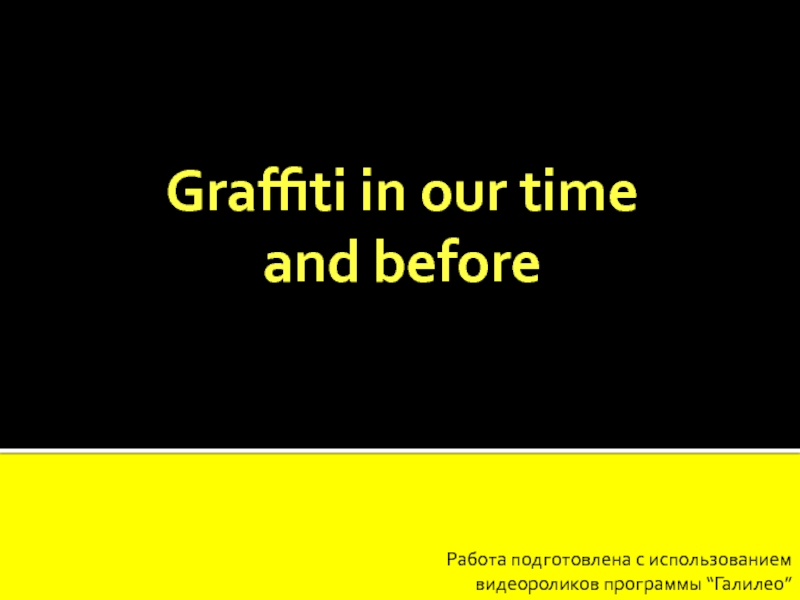
Слайд 3The word graffiti comes from the Italian word graffito. This
means any picture , drawing , inscription painted on some
surfaces, this historical term used to rock paintings, painting of the ancient world. Most of the ancient graffiti is translated as » it was me”.
Слово граффити произошло от итальянского слова граффито. Это означает любое изображение, рисунок, надпись нарисованные на какой-нибудь поверхности. Этот исторический термин используется для наскальных рисунков, живописи древнего мира. Большинство древних граффити переводится как » здесь был я».
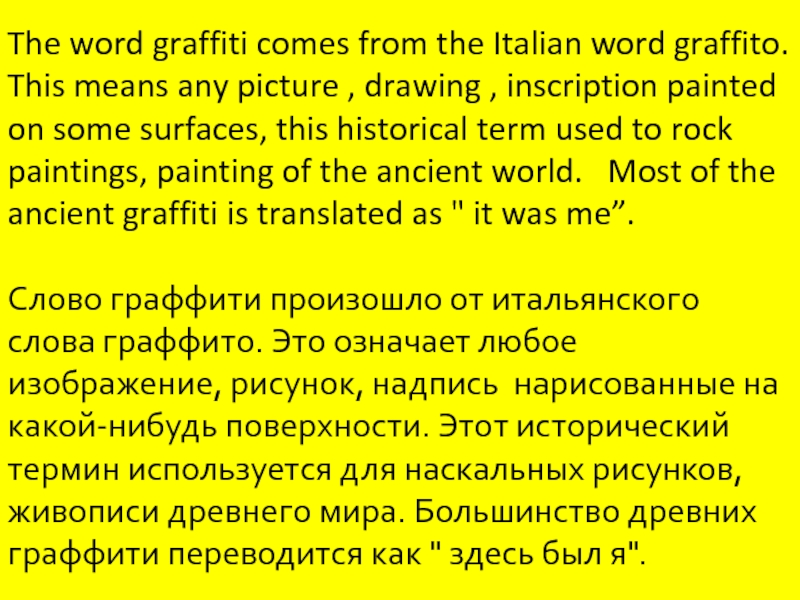
Слайд 5
In our time the art of graffiti was widely disseminated
and acquired new forms. Appeared secret code writer, the native
language version of the terms. Now you can not hide under the cover of night. There are people whose graffiti are shown in the galleries , for their creative work, pay the money. For example not so long ago in Moscow took place the festival of graffiti. A huge number of transformer booths was painted legally in each district.
В наше время искусство граффити получило широкое распространение и приобрело новые формы. Появился негласный кодекс граффитчиков , собственный язык терминов. Теперь можно не скрываться под покровом ночи. Есть люди чьи граффити показываются в галереях , за их творческую работу платят деньги. Например не так давно в Москве прошел фестиваль граффити. Огромное количество трансформаторных будок было расписано легально в каждом округе.
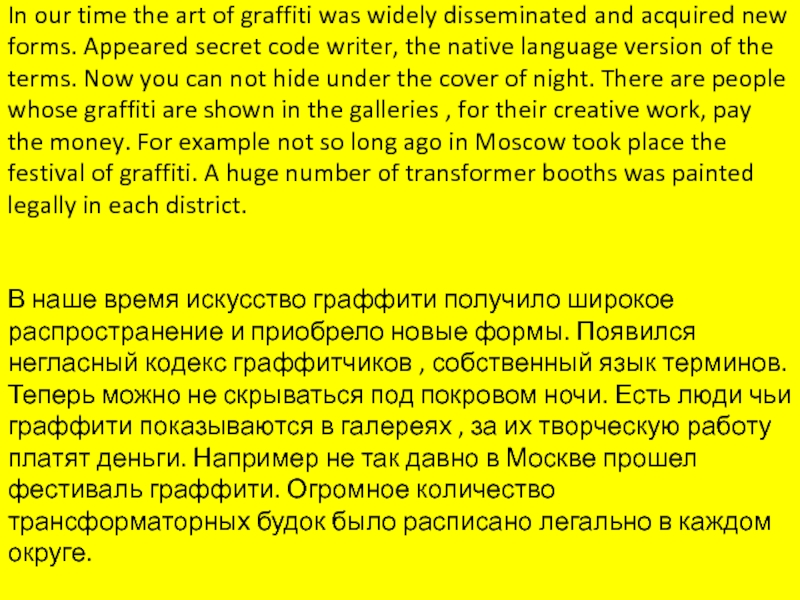
Слайд 7The real professionals of their work are not hidden .
their work is so popular and lovely , that are
in demand. Writers are those who draw graffiti to order. For example the owners of the shops do not always wash off with wall graffiti, because sometimes it is the art of famous artists.
Настоящие профессионалы своего дела не скрываются . Их работы настолько популярны и хороши , что пользуются спросом. Райтеры это те, которые рисуют гаффити на заказ. Например владельцы магазинов не всегда смывают с ветрин граффити, ведь иногда это искусство знаменитых художников.
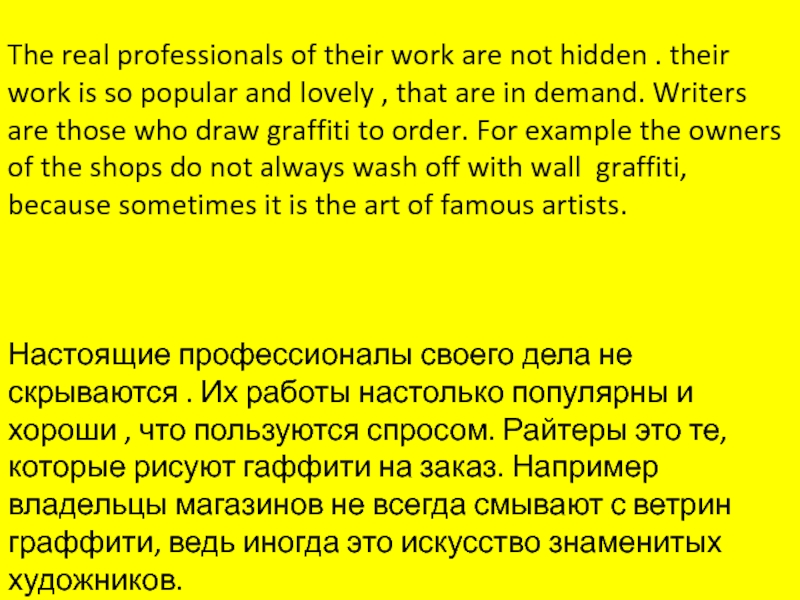
Слайд 9
Now graffiti is not only a view of the street
creativity and self-expression of himself in the city. It is
an element of design of a premise. By definition, this art is all that drawn on the wall . That’s it became fashionable to decorate the walls of the apartment large colorful graffiti.
Теперь граффити это не только вид уличного творчества и самовыражения себя в городе. Это элемент дизайна помещения. По определению этого искусства это все то что нарисовано на стене . вот и стало модно украшать стены квартиры большими красочными граффити.
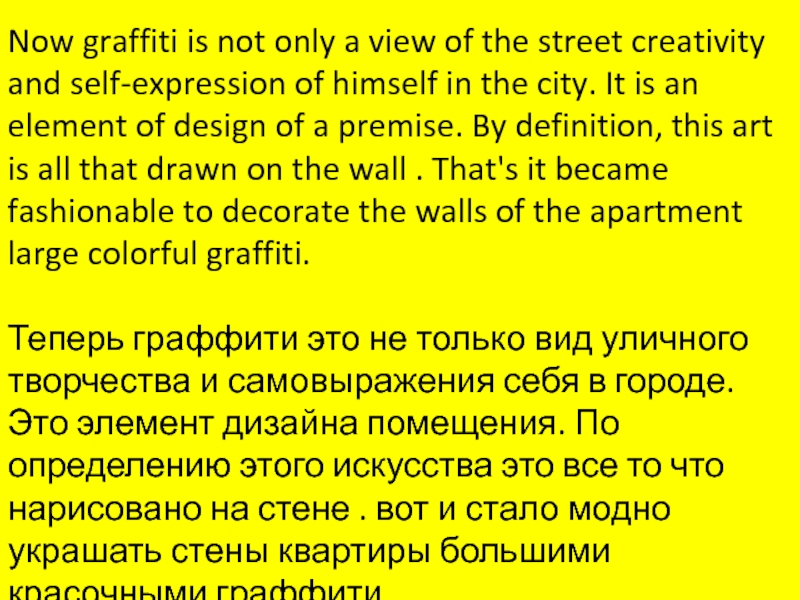
Слайд 10for those who are very interesting
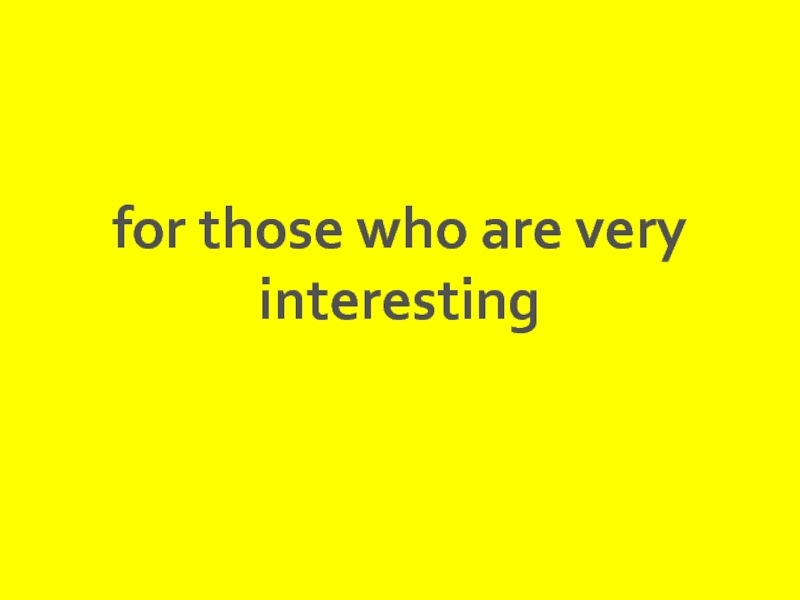
Слайд 11In historical science the term graffiti is used a long
time ago.
Technology graffiti was used in the first place potters,
which after work cut out to products of his signature. In ancient times graffiti were drawn on the walls with a sharp object, sometimes to be used for chalk or coal. Greek verb γράφειν — graphein (in Russian — «write») has the same root.
Wall inscriptions have been known since the ancient times, they open in the countries of Ancient East, in Greece, in Rome, Pompeii and the roman catacombs).
The earliest graffiti appeared in 30 b.c. Then they were presented in the form of prehistoric rock carvings engraved on the walls of tools such as the bones of animals and pigments . These drawings are often made in the ritual and the sacred places inside the caves. Most often depicted on them animals, wildlife and hunting scenes.
The first model of the «new style» graffiti is preserved in the ancient Greek city of Ephesus graffiti’s handprint, vaguely resembled that of the heart, footprint and the number of.
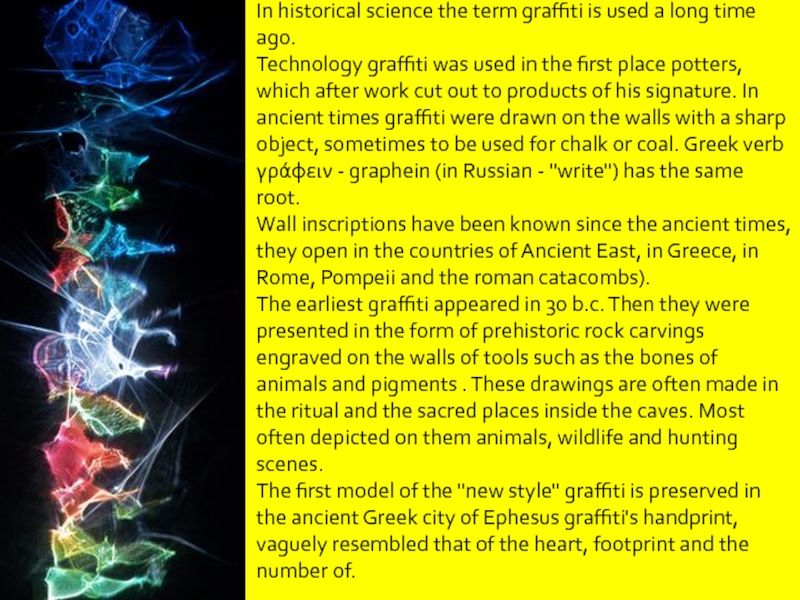
Слайд 12In Russia, the eastern slavs of graffiti have a long
and rich history. In Novgorod preserved 10 graffiti of the
XI century. A large number of graffiti XI-XV centuries is in the cathedral of sts. Sophia in Kiev, they contain as drawings, or (more often) the text. The greater part of the ancient Russian graffiti is writing on the walls of temples, therefore, the most frequent their content — prayer requests to God or the saints, but there are also humorous texts and records of type «here was so-and-so, «and the people’s spells. Many graffiti contain the exact date and are an important historical source.
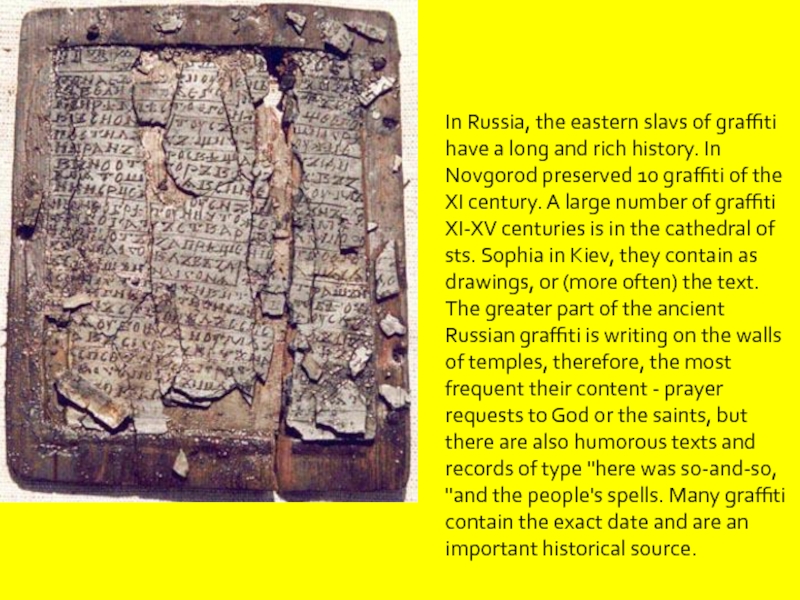
Слайд 13The Revival of the artists of the Renaissance, such as
Пинтуриккьо, Raphael, Michelangelo, Ghirlandaio or Filippino Lippi when down in
the ruins of the Golden house of Nero, cut out or painted their names
On some of the Egyptian pyramids discovered graffiti, submitted by the French soldiers during the time of the Egyptian campaign of Napoleon . Lord Byron left their mark on one of the columns in the temple of Poseidon at Cape Sounion in the region of Attica
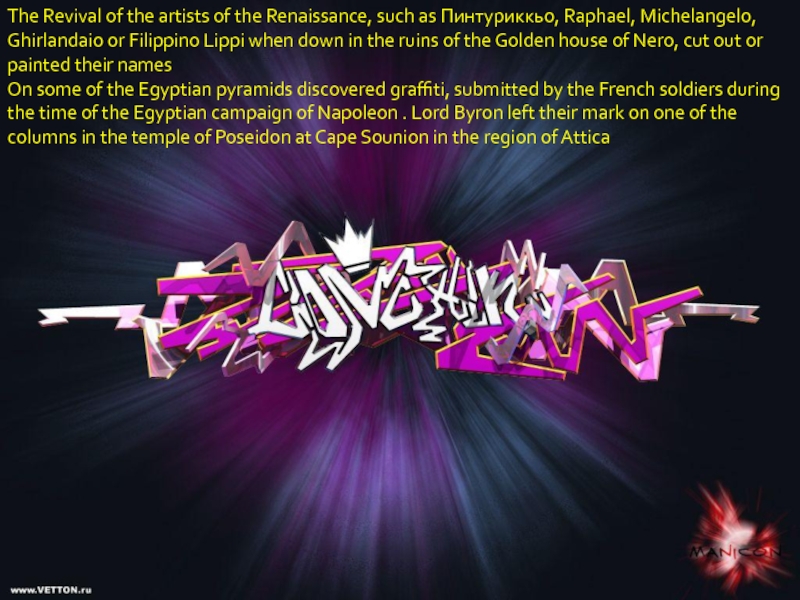
Слайд 14Graffiti today — the kind of street art, one of
the most actual forms of artistic expression around the world.
There are many different styles and types of graffiti. Works, created by graffiti-artists- an independent genre of contemporary art, an integral part of the culture and the urban way of life. In many countries and cities have their famous writers, which in the streets of the city real masterpieces.
In most countries of the world, drawing graffiti on someone’s property without permission from the owner of the property is considered vandalism and punished by law
At this time, in Russia there are about 100 teams, well dealing with graffiti (of which about 70 in Moscow and st. Petersburg). To name a few, the most well-known commands: Moby Crew, BFG Team, Uptown Moscow Crew, Depict Crew, SPP Crew, STC and GZ Crew «
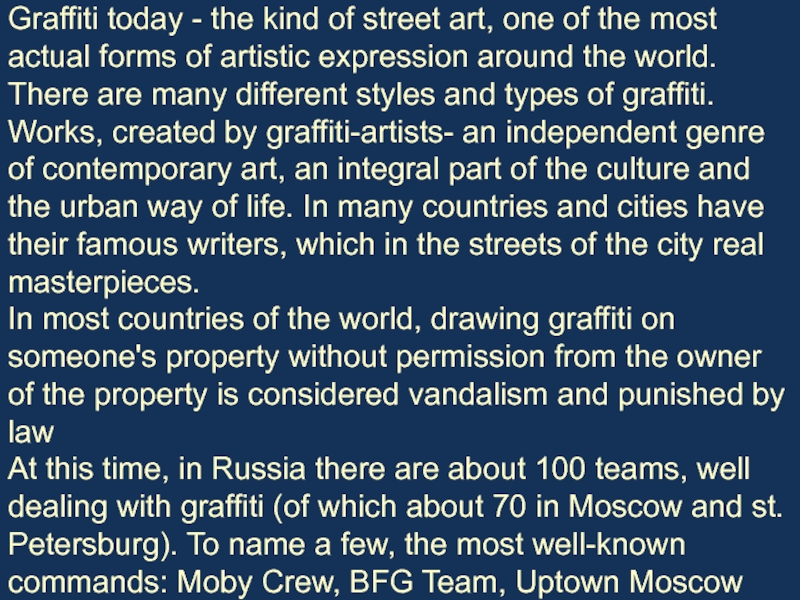
Слайд 15VIVACITY is the largest graffiti portal in the space of
the Russian web-sites on graffiti.
In translation from English — «long
live the city. “Second name project — Russian Tower (A Tower). Graffiti edition exclusive portfolio, latest news, videos, projects, reports and much more on the VIVACITY.
Artists and photographers
The idea is to acquaint with the personal portfolio of artists, photographers, in order to provide information about the Russian graffiti in the internet.
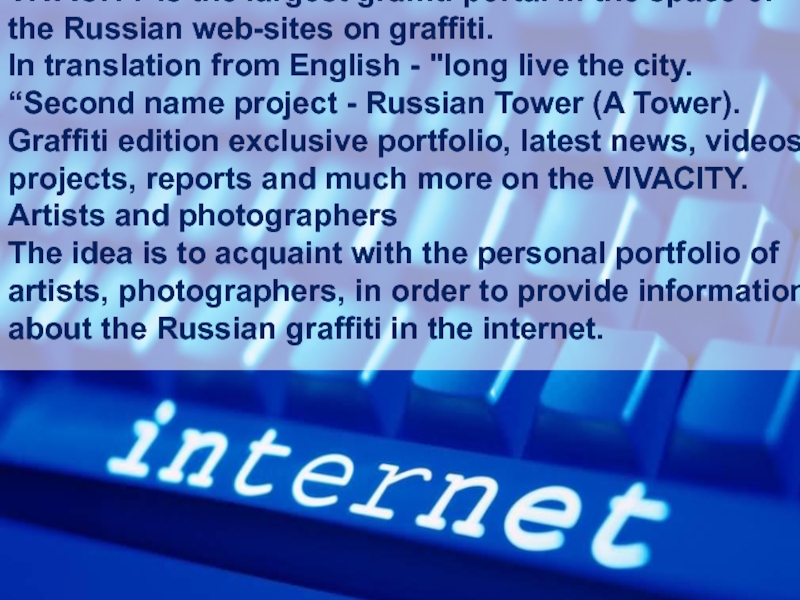
Слайд 16Do not draw on the buildings of cultural value, do
not write the names of other writers, especially on other
people’s work, on the coffins: painting memorial walls and machines is death! Those who write on other people’s work, deserve contempt.
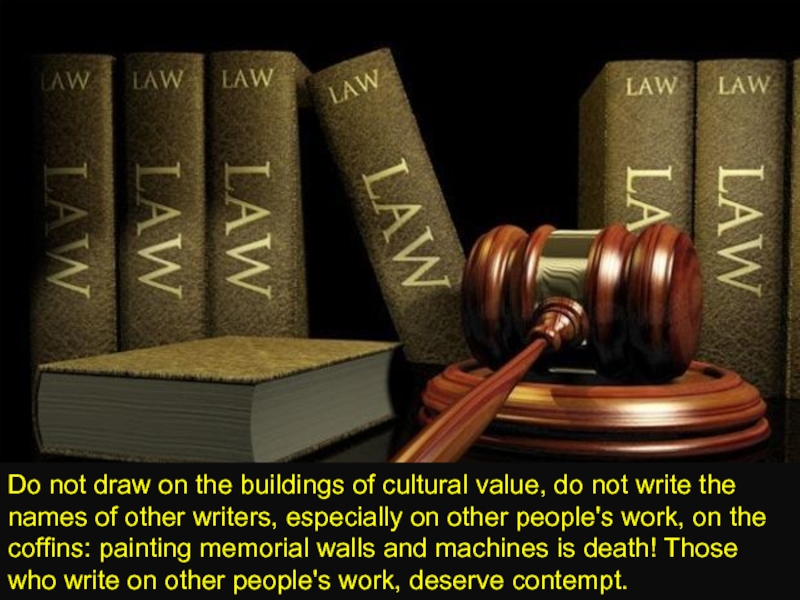
Introduction
Graffiti as we know it may have a relatively short history but has managed to touch almost every corner of the globe. LETTERS used to dominate but today the culture has expanded: new forms are explored, and characters, symbols and abstractions have become more popular.
Graffiti Art Materials

Over the past few years graffiti artists have been using a wider range of material and expression. Stickers, posters, stencils, airbrush, oil-based chalk and all varieties of paint and even sculpture are being used.
Most artists have expanded beyond relying solely on the spraycan. As a result, many people now refer to this type of art as the post-graffiti movement. Incidentally, nationality, race and sex have no bearing or merit on the graffiti scene.
World Wide History of Graffiti
The word graffiti is derived from the Italian terms graffio, meaning scratch. Graffiti has been around since prehistoric caveman discovered how to blow colored powder and carve images on cave walls.
In ancient Greece, fragments of clay were found on which notes had been carved. Pompeii excavations revealed graffiti, including election slogans, drawings and even obscenities. In fact, graffiti can be found all over the history of the world including: WWII propaganda from the Nazi party and resistant groups.
The Beginnings
Today’s graffiti developed towards the end of the 1970s in New York and Philadelphia. Artists such as Taki 183 (NY), Julio 204 (NY), Cat 161 and Cornbread (Philadelphia) painted their names on walls or in subway stations around Manhattan and Philadelphia.
The unique make-up of New York City- in which the Harlem slums and the glamorous world of Broadway stand side by side- seems to have been a breeding ground for the first graffiti artists, bringing together many different cultures and classes in one place.
This environment fueled an artistic battle against the powerful and wealthy and those living in poverty in the ghetto. For example, CornBread became notorious by spray painting his “tag” (the name of the graffiti artist) on an elephant in the Philadelphia Zoo and on the side of the Jackson 5’s private jet.

Initially graffiti artists used their real names or nicknames, but soon the first pseudonyms started to appear. Tags got bigger and bigger until the first ‘pieces’ (short for masterpieces) appeared on New York trains. Artists initially targeted trains because million of people could potentially see the piece. The huge phenomenon eventually led to the gating of train lots and regular buffing of trains. This trend of train tagging , quickly caught on in Europe. The popularity of graffiti lead to movements and exhibits in Amsterdam and Antwerp, finding roots in the punk scene.

William Anderson (Schoolworkhelper Editorial Team)
Tutor and Freelance Writer. Science Teacher and Lover of Essays. Article last reviewed: 2020 | St. Rosemary Institution © 2010-2022 | Creative Commons 4.0
Graffiti (plural; singular graffiti or graffito, the latter rarely used except in archeology) is art that is written, painted or drawn on a wall or other surface, usually without permission and within public view.[1][2] Graffiti ranges from simple written words to elaborate wall paintings, and has existed since ancient times, with examples dating back to ancient Egypt, ancient Greece, and the Roman Empire (see also mural).[3]
Graffiti is a controversial subject. In most countries, marking or painting property without permission is considered by property owners and civic authorities as defacement and vandalism, which is a punishable crime, citing the use of graffiti by street gangs to mark territory or to serve as an indicator of gang-related activities.[4] Graffiti has become visualized as a growing urban «problem» for many cities in industrialized nations, spreading from the New York City subway system and Philadelphia in the early 1970s to the rest of the United States and Europe and other world regions.[5]
Etymology
«Graffiti» (usually both singular and plural) and the rare singular form «graffito» are from the Italian word graffiato («scratched»).[6][1][2] The term «graffiti» is used in art history for works of art produced by scratching a design into a surface. A related term is «sgraffito»,[7] which involves scratching through one layer of pigment to reveal another beneath it. This technique was primarily used by potters who would glaze their wares and then scratch a design into it. In ancient times graffiti were carved on walls with a sharp object, although sometimes chalk or coal were used. The word originates from Greek γράφειν—graphein—meaning «to write».[8]
History
Figure graffito, similar to a relief, at the Castellania, in Valletta
The term graffiti originally referred to the inscriptions, figure drawings, and such, found on the walls of ancient sepulchres or ruins, as in the Catacombs of Rome or at Pompeii. Use of the word has evolved to include any graphics applied to surfaces in a manner that constitutes vandalism.[9]
The only known source of the Safaitic language, an ancient form of Arabic, is from graffiti: inscriptions scratched on to the surface of rocks and boulders in the predominantly basalt desert of southern Syria, eastern Jordan and northern Saudi Arabia. Safaitic dates from the first century BC to the fourth century AD.[10][11]
Modern-style graffiti
The first known example of «modern style»[clarification needed] graffiti survives in the ancient Greek city of Ephesus (in modern-day Turkey). Local guides say it is an advertisement for prostitution. Located near a mosaic and stone walkway, the graffiti shows a handprint that vaguely resembles a heart, along with a footprint, a number, and a carved image of a woman’s head.
The ancient Romans carved graffiti on walls and monuments, examples of which also survive in Egypt. Graffiti in the classical world had different connotations than they carry in today’s society concerning content. Ancient graffiti displayed phrases of love declarations, political rhetoric, and simple words of thought, compared to today’s popular messages of social and political ideals.[12]
The eruption of Vesuvius preserved graffiti in Pompeii, which includes Latin curses, magic spells, declarations of love, insults, alphabets, political slogans, and famous literary quotes, providing insight into ancient Roman street life. One inscription gives the address of a woman named Novellia Primigenia of Nuceria, a prostitute, apparently of great beauty, whose services were much in demand. Another shows a phallus accompanied by the text, mansueta tene («handle with care»).
Disappointed love also found its way onto walls in antiquity:
Quisquis amat. veniat. Veneri volo frangere costas
fustibus et lumbos debilitare deae.
Si potest illa mihi tenerum pertundere pectus
quit ego non possim caput illae frangere fuste?Whoever loves, go to hell. I want to break Venus’s ribs
with a club and deform her hips.
If she can break my tender heart
why can’t I hit her over the head?— CIL IV, 1824.[13]
Ancient tourists visiting the 5th-century citadel at Sigiriya in Sri Lanka scribbled over 1800 individual graffiti there between the 6th and 18th centuries. Etched on the surface of the Mirror Wall, they contain pieces of prose, poetry, and commentary. The majority of these visitors appear to have been from the elite of society: royalty, officials, professions, and clergy. There were also soldiers, archers, and even some metalworkers. The topics range from love to satire, curses, wit, and lament. Many demonstrate a very high level of literacy and a deep appreciation of art and poetry.[14] Most of the graffiti refer to the frescoes of semi-nude females found there. One reads:
Wet with cool dew drops
fragrant with perfume from the flowers
came the gentle breeze
jasmine and water lily
dance in the spring sunshine
side-long glances
of the golden-hued ladies
stab into my thoughts
heaven itself cannot take my mind
as it has been captivated by one lass
among the five hundred I have seen here.[15]
Among the ancient political graffiti examples were Arab satirist poems. Yazid al-Himyari, an Umayyad Arab and Persian poet, was most known for writing his political poetry on the walls between Sajistan and Basra, manifesting a strong hatred towards the Umayyad regime and its walis, and people used to read and circulate them very widely.[16][clarification needed]
Level of literacy often evident in graffiti
Historic forms of graffiti have helped gain understanding into the lifestyles and languages of past cultures. Errors in spelling and grammar in these graffiti offer insight into the degree of literacy in Roman times and provide clues on the pronunciation of spoken Latin. Examples are CIL IV, 7838: Vettium Firmum / aed[ilem] quactiliar[ii] [sic] rog[ant]. Here, «qu» is pronounced «co». The 83 pieces of graffiti found at CIL IV, 4706-85 are evidence of the ability to read and write at levels of society where literacy might not be expected. The graffiti appear on a peristyle which was being remodeled at the time of the eruption of Vesuvius by the architect Crescens. The graffiti were left by both the foreman and his workers. The brothel at CIL VII, 12, 18–20 contains more than 120 pieces of graffiti, some of which were the work of the prostitutes and their clients. The gladiatorial academy at CIL IV, 4397 was scrawled with graffiti left by the gladiator Celadus Crescens (Suspirium puellarum Celadus thraex: «Celadus the Thracian makes the girls sigh.»)
Another piece from Pompeii, written on a tavern wall about the owner of the establishment and his questionable wine:
Landlord, may your lies malign
Bring destruction on your head!
You yourself drink unmixed wine,
Water [do you] sell [to] your guests instead.[17]
It was not only the Greeks and Romans who produced graffiti: the Maya site of Tikal in Guatemala contains examples of ancient Maya graffiti. Viking graffiti survive in Rome and at Newgrange Mound in Ireland, and a Varangian scratched his name (Halvdan) in runes on a banister in the Hagia Sophia at Constantinople. These early forms of graffiti have contributed to the understanding of lifestyles and languages of past cultures.
Graffiti, known as Tacherons, were frequently scratched on Romanesque Scandinavian church walls.[18]
When Renaissance artists such as Pinturicchio, Raphael, Michelangelo, Ghirlandaio, or Filippino Lippi descended into the ruins of Nero’s Domus Aurea, they carved or painted their names and returned to initiate the grottesche style of decoration.[19][20]
There are also examples of graffiti occurring in American history, such as Independence Rock, a national landmark along the Oregon Trail.[21]
Later, French soldiers carved their names on monuments during the Napoleonic campaign of Egypt in the 1790s.[22] Lord Byron’s survives on one of the columns of the Temple of Poseidon at Cape Sounion in Attica, Greece.[23]
- Ancient graffiti
-
Ironic wall inscription commenting on boring graffiti
-
-
-
Crusader graffiti in the Church of the Holy Sepulchre
-
-
Contemporary graffiti
Contemporary graffiti art has its origins with young people in 1970s New York. They would use spray paint and other kind of materials to create an image on the sides of buildings and subway trains. [24] While the art was a form of masterpiece, it was also causing problems on subways due to the fact that people could not look out of the widows because they were covered in tags.[25] To the people doing the tags it was to them a form of writing it was not until a novelist named Norman Mailer called it «Graffiti» in The New York Times.[25] During this time period (the late 70s), a war against graffiti broke out, making it so graffitist cannot tag subway trains without getting in trouble anymore, so they moved on to tagging rooftops and canvases.[25] However, today graffitist are paid thousands of dollars to put there artwork on buildings and on canvases to display the amazing works that the artist has done.[26]
Contemporary graffiti style has been heavily influenced by hip hop culture[27] and the myriad international styles derived from Philadelphia and New York City Subway graffiti, however, there are many other traditions of notable graffiti in the twentieth century. Graffiti have long appeared on building walls, in latrines, railroad boxcars, subways, and bridges.
The oldest known example of modern graffiti are the «monikers» found on traincars created by hobos and railworkers since the late 1800s. The Bozo Texino monikers were documented by filmmaker Bill Daniel in his 2005 film, Who is Bozo Texino?.[28][29]
Some graffiti have their own poignancy. In World War II, an inscription on a wall at the fortress of Verdun was seen as an illustration of the US response twice in a generation to the wrongs of the Old World:[30][31]
Austin White – Chicago, Ill – 1918
Austin White – Chicago, Ill – 1945
This is the last time I want to write my name here.
During World War II and for decades after, the phrase «Kilroy was here» with an accompanying illustration was widespread throughout the world, due to its use by American troops and ultimately filtering into American popular culture. Shortly after the death of Charlie Parker (nicknamed «Yardbird» or «Bird»), graffiti began appearing around New York with the words «Bird Lives».[32] The student protests and general strike of May 1968 saw Paris bedecked in revolutionary, anarchistic, and situationist slogans such as L’ennui est contre-révolutionnaire («Boredom is counterrevolutionary») expressed in painted graffiti, poster art, and stencil art. At the time in the US, other political phrases (such as «Free Huey» about Black Panther Huey Newton) became briefly popular as graffiti in limited areas, only to be forgotten. A popular graffito of the early 1970s was «Dick Nixon Before He Dicks You», reflecting the hostility of the youth culture to that US president.
- World War II graffiti
-
Soldier with tropical fantasy graffiti (1943–1944)
-
Advent of aerosol paint
Rock and roll graffiti is a significant subgenre. A famous graffito of the twentieth century was the inscription in London reading «Clapton is God» in reference to the guitarist Eric Clapton. Creating the cult of the guitar hero, the phrase was spray-painted by an admirer on a wall in an Islington, north London in the autumn of 1967.[33] The graffito was captured in a photograph, in which a dog is urinating on the wall.[34]
Graffiti also became associated with the anti-establishment punk rock movement beginning in the 1970s. Bands such as Black Flag and Crass (and their followers) widely stenciled their names and logos, while many punk night clubs, squats, and hangouts are famous for their graffiti.
- Early spray-painted graffiti
-
Graffiti in Chicago (1973)
Spread of hip hop culture
Style Wars depicted not only famous graffitists such as Skeme, Dondi, MinOne, and ZEPHYR, but also reinforced graffiti’s role within New York’s emerging hip-hop culture by incorporating famous early break-dancing groups such as Rock Steady Crew into the film and featuring rap in the soundtrack. Although many officers of the New York City Police Department found this film to be controversial, Style Wars is still recognized as the most prolific film representation of what was going on within the young hip hop culture of the early 1980s.[35] Fab 5 Freddy and Futura 2000 took hip hop graffiti to Paris and London as part of the New York City Rap Tour in 1983.[36]
Stencil graffiti emerges
This period also saw the emergence of the new stencil graffiti genre. Some of the first examples were created in 1981 by graffitists Blek le Rat in Paris, in 1982 by Jef Aerosol in Tours (France);[citation needed] by 1985 stencils had appeared in other cities including New York City, Sydney, and Melbourne, where they were documented by American photographer Charles Gatewood and Australian photographer Rennie Ellis.[37]
Commercialization and entrance into mainstream pop culture
With the popularity and legitimization of graffiti has come a level of commercialization. In 2001, computer giant IBM launched an advertising campaign in Chicago and San Francisco which involved people spray painting on sidewalks a peace symbol, a heart, and a penguin (Linux mascot), to represent «Peace, Love, and Linux.» IBM paid Chicago and San Francisco collectively US$120,000 for punitive damages and clean-up costs.[38][39]
In 2005, a similar ad campaign was launched by Sony and executed by its advertising agency in New York, Chicago, Atlanta, Philadelphia, Los Angeles, and Miami, to market its handheld PSP gaming system. In this campaign, taking notice of the legal problems of the IBM campaign, Sony paid building owners for the rights to paint on their buildings «a collection of dizzy-eyed urban kids playing with the PSP as if it were a skateboard, a paddle, or a rocking horse».[39]
Advocates
Marc Ecko, an urban clothing designer, has been an advocate of graffiti as an art form during this period, stating that «Graffiti is without question the most powerful art movement in recent history and has been a driving inspiration throughout my career.»[40]
Graffiti have become a common stepping stone for many members of both the art and design communities in North America and abroad. Within the United States graffitists such as Mike Giant, Pursue, Rime, Noah, and countless others have made careers in skateboard, apparel, and shoe design for companies such as DC Shoes, Adidas, Rebel8, Osiris, or Circa[41] Meanwhile, there are many others such as DZINE, Daze, Blade, and The Mac who have made the switch to being gallery artists, often not even using their initial medium, spray paint.[41]
Global developments
South America
Tristan Manco wrote that Brazil «boasts a unique and particularly rich, graffiti scene … [earning] it an international reputation as the place to go for artistic inspiration.» Graffiti «flourishes in every conceivable space in Brazil’s cities.» Artistic parallels «are often drawn between the energy of São Paulo today and 1970s New York.» The «sprawling metropolis,» of São Paulo has «become the new shrine to graffiti;» Manco alludes to «poverty and unemployment … [and] the epic struggles and conditions of the country’s marginalised peoples,» and to «Brazil’s chronic poverty,» as the main engines that «have fuelled a vibrant graffiti culture.» In world terms, Brazil has «one of the most uneven distributions of income. Laws and taxes change frequently.» Such factors, Manco argues, contribute to a very fluid society, riven with those economic divisions and social tensions that underpin and feed the «folkloric vandalism and an urban sport for the disenfranchised,» that is South American graffiti art.[42]
A graffiti piece found in Tel Aviv by the artist DeDe
Prominent Brazilian graffitists include Os Gêmeos, Boleta, Nunca, Nina, Speto, Tikka, and T.Freak.[43] Their artistic success and involvement in commercial design ventures[44] has highlighted divisions within the Brazilian graffiti community between adherents of the cruder transgressive form of pichação and the more conventionally artistic values of the practitioners of grafite.[45]
Middle East
Graffiti in the Middle East has emerged slowly, with taggers operating in Egypt, Lebanon, the Gulf countries like Bahrein or the United Arab Emirates,[46] Israel, and in Iran. The major Iranian newspaper Hamshahri has published two articles on illegal writers in the city with photographic coverage of Iranian artist A1one’s works on Tehran walls. Tokyo-based design magazine, PingMag, has interviewed A1one and featured photographs of his work.[47] The Israeli West Bank barrier has become a site for graffiti, reminiscent in this sense of the Berlin Wall. Many graffitists in Israel come from other places around the globe, such as JUIF from Los Angeles and DEVIONE from London. The religious reference «נ נח נחמ נחמן מאומן» («Na Nach Nachma Nachman Meuman») is commonly seen in graffiti around Israel.
Graffiti has played an important role within the street art scene in the Middle East and North Africa (MENA), especially following the events of the Arab Spring of 2011 or the Sudanese Revolution of 2018/19.[48] Graffiti is a tool of expression in the context of conflict in the region, allowing people to raise their voices politically and socially. Famous street artist Banksy has had an important effect in the street art scene in the MENA area, especially in Palestine where some of his works are located in the West Bank barrier and Bethlehem.[49]
Southeast Asia
There are also a large number of graffiti influences in Southeast Asian countries that mostly come from modern Western culture, such as Malaysia, where graffiti have long been a common sight in Malaysia’s capital city, Kuala Lumpur. Since 2010, the country has begun hosting a street festival to encourage all generations and people from all walks of life to enjoy and encourage Malaysian street culture.[50]
- Graffiti around the world
-
-
-
Characteristics of common graffiti
Methods and production
The modern-day graffitists can be found with an arsenal of various materials that allow for a successful production of a piece.[51] This includes such techniques as scribing. However, spray paint in aerosol cans is the number one medium for graffiti. From this commodity comes different styles, technique, and abilities to form master works of graffiti. Spray paint can be found at hardware and art stores and comes in virtually every color.
Stencil graffiti is created by cutting out shapes and designs in a stiff material (such as cardboard or subject folders) to form an overall design or image. The stencil is then placed on the «canvas» gently and with quick, easy strokes of the aerosol can, the image begins to appear on the intended surface.
- Graffiti making
-
The first graffiti shop in Russia was opened in 1992 in Tver
-
Graffiti application at Eurofestival in Turku, Finland
-
Graffiti application in India using natural pigments (mostly charcoal, plant saps, and dirt)
-
A graffiti artist at work in London
Modern experimentation
Spiderweb Yarnbomb Installation by Stephen Duneier both hides and highlights previous graffiti.
Modern graffiti art often incorporates additional arts and technologies. For example, Graffiti Research Lab has encouraged the use of projected images and magnetic light-emitting diodes (throwies) as new media for graffitists. Yarnbombing is another recent form of graffiti. Yarnbombers occasionally target previous graffiti for modification, which had been avoided among the majority of graffitists.
Tagging
Tagging is the practice of someone spray-painting «their name, initial or logo onto a public surface».[52]
A tag in Dallas, reading «Spore»
A number of recent examples of graffiti make use of hashtags.[53][54]
Densely-tagged parking area in Århus, Denmark
Uses
Theories on the use of graffiti by avant-garde artists have a history dating back at least to the Asger Jorn, who in 1962 painting declared in a graffiti-like gesture «the avant-garde won’t give up».[55]
Many contemporary analysts and even art critics have begun to see artistic value in some graffiti and to recognize it as a form of public art. According to many art researchers, particularly in the Netherlands and in Los Angeles, that type of public art is, in fact an effective tool of social emancipation or, in the achievement of a political goal.[56]
In times of conflict, such murals have offered a means of communication and self-expression for members of these socially, ethnically, or racially divided communities, and have proven themselves as effective tools in establishing dialog and thus, of addressing cleavages in the long run. The Berlin Wall was also extensively covered by graffiti reflecting social pressures relating to the oppressive Soviet rule over the GDR.
Many artists involved with graffiti are also concerned with the similar activity of stenciling. Essentially, this entails stenciling a print of one or more colors using spray-paint. Recognized while exhibiting and publishing several of her coloured stencils and paintings portraying the Sri Lankan Civil War and urban Britain in the early 2000s, graffitists Mathangi Arulpragasam, aka M.I.A., has also become known for integrating her imagery of political violence into her music videos for singles «Galang» and «Bucky Done Gun», and her cover art. Stickers of her artwork also often appear around places such as London in Brick Lane, stuck to lamp posts and street signs, she having become a muse for other graffitists and painters worldwide in cities including Seville.
Graffitist believes that art should be on display for everyone in the public eye or in plain sight, not hidden away in a museum or a gallery. [57]Art should color the streets, not the inside of some building. Graffiti is a form of art that can’t be owned or bought. It doesn’t last forever, it’s temporary, yet one of a kind. It’s a form of self promotion for the artist that can be displayed anywhere form sidewalks, roofs, subways, building wall, and etc. [57] Art to them is for everyone and should be showed to everyone for free.
Personal expression
Graffiti is a way of communicating and a way of expressing what one feels in the moment. It is both art and a functional thing that can warn people of something or inform people of something. However, graffiti is to some people a form of art, but to some a form of vandalism.[58] And many graffitists choose to protect their identities and remain anonymous or to hinder prosecution.
With the commercialization of graffiti (and hip hop in general), in most cases, even with legally painted «graffiti» art, graffitists tend to choose anonymity. This may be attributed to various reasons or a combination of reasons. Graffiti still remains the one of four hip hop elements that is not considered «performance art» despite the image of the «singing and dancing star» that sells hip hop culture to the mainstream. Being a graphic form of art, it might also be said that many graffitists still fall in the category of the introverted archetypal artist.
Banksy is one of the world’s most notorious and popular street artists who continues to remain faceless in today’s society.[59] He is known for his political, anti-war stencil art mainly in Bristol, England, but his work may be seen anywhere from Los Angeles to Palestine. In the UK, Banksy is the most recognizable icon for this cultural artistic movement and keeps his identity a secret to avoid arrest. Much of Banksy’s artwork may be seen around the streets of London and surrounding suburbs, although he has painted pictures throughout the world, including the Middle East, where he has painted on Israel’s controversial West Bank barrier with satirical images of life on the other side. One depicted a hole in the wall with an idyllic beach, while another shows a mountain landscape on the other side. A number of exhibitions also have taken place since 2000, and recent works of art have fetched vast sums of money. Banksy’s art is a prime example of the classic controversy: vandalism vs. art. Art supporters endorse his work distributed in urban areas as pieces of art and some councils, such as Bristol and Islington, have officially protected them, while officials of other areas have deemed his work to be vandalism and have removed it.
Pixnit is another artist who chooses to keep her identity from the general public.[60] Her work focuses on beauty and design aspects of graffiti as opposed to Banksy’s anti-government shock value. Her paintings are often of flower designs above shops and stores in her local urban area of Cambridge, Massachusetts. Some store owners endorse her work and encourage others to do similar work as well. «One of the pieces was left up above Steve’s Kitchen, because it looks pretty awesome»- Erin Scott, the manager of New England Comics in Allston, Massachusetts.[61]
Graffiti artists may become offended if photographs of their art are published in a commercial context without their permission. In March 2020, the Finnish graffiti artist Psyke expressed his displeasure at the newspaper Ilta-Sanomat publishing a photograph of a Peugeot 208 in an article about new cars, with his graffiti prominently shown on the background. The artist claims he does not want his art being used in commercial context, not even if he were to receive compensation.[62]
- Personal graffiti
-
Inscription in Pompeii lamenting a frustrated love, «Whoever loves, let him flourish, let him perish who knows not love, let him perish twice over whoever forbids love.»
-
-
Territorial
Territorial graffiti marks urban neighborhoods with tags and logos to differentiate certain groups from others. These images are meant to show outsiders a stern look at whose turf is whose. The subject matter of gang-related graffiti consists of cryptic symbols and initials strictly fashioned with unique calligraphies. Gang members use graffiti to designate membership throughout the gang, to differentiate rivals and associates and, most commonly, to mark borders which are both territorial and ideological.[63]
As advertising
Graffiti has been used as a means of advertising both legally and illegally. Bronx-based TATS CRU has made a name for themselves doing legal advertising campaigns for companies such as Coca-Cola, McDonald’s, Toyota, and MTV. In the UK, Covent Garden’s Boxfresh used stencil images of a Zapatista revolutionary in the hopes that cross referencing would promote their store.
Smirnoff hired artists to use reverse graffiti (the use of high pressure hoses to clean dirty surfaces to leave a clean image in the surrounding dirt) to increase awareness of their product.
- Advertising graffiti
-
Graffiti as advertising in Haikou, Hainan Province, China, which is an extremely common form of graffiti seen throughout the country
-
Graffiti as legal advertising on a grocer’s shop window in Warsaw, Poland
Radical and political
Graffiti often has a reputation as part of a subculture that rebels against authority, although the considerations of the practitioners often diverge and can relate to a wide range of attitudes. It can express a political practice and can form just one tool in an array of resistance techniques. One early example includes the anarcho-punk band Crass, who conducted a campaign of stenciling anti-war, anarchist, feminist, and anti-consumerist messages throughout the London Underground system during the late 1970s and early 1980s.[64] In Amsterdam graffiti was a major part of the punk scene. The city was covered with names such as «De Zoot», «Vendex», and «Dr Rat».[65] To document the graffiti a punk magazine was started that was called Gallery Anus. So when hip hop came to Europe in the early 1980s there was already a vibrant graffiti culture.
The student protests and general strike of May 1968 saw Paris bedecked in revolutionary, anarchistic, and situationist slogans such as L’ennui est contre-révolutionnaire («Boredom is counterrevolutionary») and Lisez moins, vivez plus («Read less, live more»). While not exhaustive, the graffiti gave a sense of the ‘millenarian’ and rebellious spirit, tempered with a good deal of verbal wit, of the strikers.
I think graffiti writing is a way of defining what our generation is like. Excuse the French, we’re not a bunch of p—- artists. Traditionally artists have been considered soft and mellow people, a little bit kooky. Maybe we’re a little bit more like pirates that way. We defend our territory, whatever space we steal to paint on, we defend it fiercely.
—Sandra «Lady Pink» Fabara[66]
The developments of graffiti art which took place in art galleries and colleges as well as «on the street» or «underground», contributed to the resurfacing in the 1990s of a far more overtly politicized art form in the subvertising, culture jamming, or tactical media movements. These movements or styles tend to classify the artists by their relationship to their social and economic contexts, since, in most countries, graffiti art remains illegal in many forms except when using non-permanent paint. Since the 1990s with the rise of Street Art, a growing number of artists are switching to non-permanent paints and non-traditional forms of painting.[67][68]
Contemporary practitioners, accordingly, have varied and often conflicting practices. Some individuals, such as Alexander Brener, have used the medium to politicize other art forms, and have used the prison sentences enforced on them as a means of further protest.[69]
The practices of anonymous groups and individuals also vary widely, and practitioners by no means always agree with each other’s practices. For example, the anti-capitalist art group the Space Hijackers did a piece in 2004 about the contradiction between the capitalistic elements of Banksy and his use of political imagery.[70][71]
Berlin human rights activist Irmela Mensah-Schramm has received global media attention and numerous awards for her 35-year campaign of effacing neo-Nazi and other right-wing extremist graffiti throughout Germany, often by altering hate speech in humorous ways.[72][73]
- Political graffiti around the world
-
Graffiti with orthodox cross at the Catholic Church in Ystad 2021.
-
-
Anti Iraqi war graffiti by street artist Sony Montana in Cancun, Mexico (2007)
-
WWII bunker near Anhalter Bahnhof (Berlin) with a graffiti inscription Wer Bunker baut, wirft Bomben (those who build bunkers, throw bombs)
-
Graffiti on the train line leading to Central Station in Amsterdam
-
Stencil in Pieksämäki representing former president of Finland, Urho Kekkonen, well known in Finnish popular culture
-
Berlin Wall: «Anyone who wants to keep the world as it is, does not want it to remain»
Genocide denial
In Serbian capital, Belgrade, the graffiti depicting a uniformed former general of Serb army and war criminal, convicted at ICTY for war crimes and crimes against humanity, including genocide and ethnic cleansing in Bosnian War, Ratko Mladić, appeared in a military salute alongside the words, «General, thank to your mother».[74]
Aleks Eror, Berlin-based journalist, explains how «veneration of historical and wartime figures» through street art is not a new phenomenon in the region of former Yugoslavia, and that «in most cases is firmly focused on the future, rather than retelling the past».[75] Eror is not only analyst pointing to danger of such an expressions for the region’s future. In a long expose on the subject of Bosnian genocide denial, at Balkan Diskurs magazine and multimedia platform website, Kristina Gadže and Taylor Whitsell referred to these experiences as a young generations’ «cultural heritage», in which young are being exposed to celebration and affirmation of war-criminals as part of their «formal education» and «inheritance».[76]
There are numerous examples of genocide denial through celebration and affirmation of war criminals throughout the region of Western Balkans inhabited by Serbs using this form of artistic expression. Several more of these graffiti are found in Serbian capital, and many more across Serbia and Bosnian and Herzegovinian administrative entity, Republika Srpska, which is the ethnic Serbian majority enclave.[75][77] Critics point that Serbia as a state, is willing to defend the mural of convicted war criminal, and have no intention to react on cases of genocide denial, noting that Interior Minister of Serbia, Aleksandar Vulin decision to ban any gathering with an intent to remove the mural, with the deployment of riot police, sends the message of «tacit endorsement».[74][78] Consequently, on 9 November 2021, Serbian heavy police in riot gear, with graffiti creators and their supporters,[76] blocked the access to the mural to prevent human rights groups and other activists to paint over it and mark the International Day Against Fascism and Antisemitism in that way,[74] and even arrested two civic activist for throwing eggs at the graffiti.[78]
Offensive graffiti
Graffiti may also be used as an offensive expression. This form of graffiti may be difficult to identify, as it is mostly removed by the local authority (as councils which have adopted strategies of criminalization also strive to remove graffiti quickly).[79] Therefore, existing racist graffiti is mostly more subtle and at first sight, not easily recognized as «racist». It can then be understood only if one knows the relevant «local code» (social, historical, political, temporal, and spatial), which is seen as heteroglot and thus a ‘unique set of conditions’ in a cultural context.[80]
- A spatial code for example, could be that there is a certain youth group in an area that is engaging heavily in racist activities. So, for residents (knowing the local code), a graffiti containing only the name or abbreviation of this gang already is a racist expression, reminding the offended people of their gang activities. Also a graffiti is in most cases, the herald of more serious criminal activity to come.[81] A person who does not know these gang activities would not be able to recognize the meaning of this graffiti. Also if a tag of this youth group or gang is placed on a building occupied by asylum seekers, for example, its racist character is even stronger.
By making the graffiti less explicit (as adapted to social and legal constraints),[82] these drawings are less likely to be removed, but do not lose their threatening and offensive character.[83]
Elsewhere, activists in Russia have used painted caricatures of local officials with their mouths as potholes, to show their anger about the poor state of the roads.[84] In Manchester, England a graffitists painted obscene images around potholes, which often resulted in them being repaired within 48 hours.[85]
Decorative and high art
A bronze work by Jonesy on a wall in Brick Lane (London). Diameter about 8 cm.
In the early 1980s, the first art galleries to show graffitists to the public were Fashion Moda in the Bronx, Now Gallery and Fun Gallery, both in the East Village, Manhattan.[86][87][88][89]
A 2006 exhibition at the Brooklyn Museum displayed graffiti as an art form that began in New York’s outer boroughs and reached great heights in the early 1980s with the work of Crash, Lee, Daze, Keith Haring, and Jean-Michel Basquiat. It displayed 22 works by New York graffitists, including Crash, Daze, and Lady Pink. In an article about the exhibition in the magazine Time Out, curator Charlotta Kotik said that she hoped the exhibition would cause viewers to rethink their assumptions about graffiti.
From the 1970s onwards, Burhan Dogancay photographed urban walls all over the world; these he then archived for use as sources of inspiration for his painterly works. The project today known as «Walls of the World» grew beyond even his own expectations and comprises about 30,000 individual images. It spans a period of 40 years across five continents and 114 countries. In 1982, photographs from this project comprised a one-man exhibition titled «Les murs murmurent, ils crient, ils chantent …» (The walls whisper, shout and sing …) at the Centre Georges Pompidou in Paris.
In Australia, art historians have judged some local graffiti of sufficient creative merit to rank them firmly within the arts. Oxford University Press’s art history text Australian Painting 1788–2000 concludes with a long discussion of graffiti’s key place within contemporary visual culture, including the work of several Australian practitioners.[90]
Between March and April 2009, 150 artists exhibited 300 pieces of graffiti at the Grand Palais in Paris.[91][92]
- Street art graffiti
Environmental effects
Spray paint has many negative environmental effects. The paint contains toxic chemicals, and the can uses volatile hydrocarbon gases to spray the paint onto a surface.[93]
Volatile organic compound (VOC) leads to ground level ozone formation and most of graffiti related emissions are VOCs.[94] A 2010 paper estimates 4,862 tons of VOCs were released in the United States in activities related to graffiti.[94][95]
Government responses
Asia
In China, Mao Zedong in the 1920s used revolutionary slogans and paintings in public places to galvanise the country’s communist revolution.[96]
Based on different national conditions, many people believe that China’s attitude towards Graffiti is fierce, but in fact, according to Lance Crayon in his film Spray Paint Beijing: Graffiti in the Capital of China, Graffiti is generally accepted in Beijing, with artists not seeing much police interference. Political and religiously sensitive graffiti, however, is not allowed.[97]
In Hong Kong, Tsang Tsou Choi was known as the King of Kowloon for his calligraphy graffiti over many years, in which he claimed ownership of the area. Now some of his work is preserved officially.
In Taiwan, the government has made some concessions to graffitists. Since 2005 they have been allowed to freely display their work along some sections of riverside retaining walls in designated «Graffiti Zones».[98] From 2007, Taipei’s department of cultural affairs also began permitting graffiti on fences around major public construction sites. Department head Yong-ping Lee (李永萍) stated, «We will promote graffiti starting with the public sector, and then later in the private sector too. It’s our goal to beautify the city with graffiti». The government later helped organize a graffiti contest in Ximending, a popular shopping district. graffitists caught working outside of these designated areas still face fines up to NT$6,000 under a department of environmental protection regulation.[99] However, Taiwanese authorities can be relatively lenient, one veteran police officer stating anonymously, «Unless someone complains about vandalism, we won’t get involved. We don’t go after it proactively.»[100]
In 1993, after several expensive cars in Singapore were spray-painted, the police arrested a student from the Singapore American School, Michael P. Fay, questioned him, and subsequently charged him with vandalism. Fay pleaded guilty to vandalizing a car in addition to stealing road signs. Under the 1966 Vandalism Act of Singapore, originally passed to curb the spread of communist graffiti in Singapore, the court sentenced him to four months in jail, a fine of S$3,500 (US$2,233), and a caning. The New York Times ran several editorials and op-eds that condemned the punishment and called on the American public to flood the Singaporean embassy with protests. Although the Singapore government received many calls for clemency, Fay’s caning took place in Singapore on 5 May 1994. Fay had originally received a sentence of six strokes of the cane, but the presiding president of Singapore, Ong Teng Cheong, agreed to reduce his caning sentence to four lashes.[101]
In South Korea, Park Jung-soo was fined two million South Korean won by the Seoul Central District Court for spray-painting a rat on posters of the G-20 Summit a few days before the event in November 2011. Park alleged that the initial in «G-20» sounds like the Korean word for «rat», but Korean government prosecutors alleged that Park was making a derogatory statement about the president of South Korea, Lee Myung-bak, the host of the summit. This case led to public outcry and debate on the lack of government tolerance and in support of freedom of expression. The court ruled that the painting, «an ominous creature like a rat» amounts to «an organized criminal activity» and upheld the fine while denying the prosecution’s request for imprisonment for Park.[102]
- Graffiti in Asia
-
-
The Graffiti Piece «Tante» (by Chen Dongfan) on the surface wall of an old residential building in Hangzhou, Zhejiang
Europe
Graffiti removal in Berlin
In Europe, community cleaning squads have responded to graffiti, in some cases with reckless abandon, as when in 1992 in France a local Scout group, attempting to remove modern graffiti, damaged two prehistoric paintings of bison in the Cave of Mayrière supérieure near the French village of Bruniquel in Tarn-et-Garonne, earning them the 1992 Ig Nobel Prize in archeology.[103]
In September 2006, the European Parliament directed the European Commission to create urban environment policies to prevent and eliminate dirt, litter, graffiti, animal excrement, and excessive noise from domestic and vehicular music systems in European cities, along with other concerns over urban life.[104]
In Budapest, Hungary, both a city-backed movement called I Love Budapest and a special police division tackle the problem, including the provision of approved areas.[105]
United Kingdom
The Anti-Social Behaviour Act 2003 became Britain’s latest anti-graffiti legislation. In August 2004, the Keep Britain Tidy campaign issued a press release calling for zero tolerance of graffiti and supporting proposals such as issuing «on the spot» fines to graffiti offenders and banning the sale of aerosol paint to anyone under the age of 16.[106] The press release also condemned the use of graffiti images in advertising and in music videos, arguing that real-world experience of graffiti stood far removed from its often-portrayed «cool» or «edgy'» image.
To back the campaign, 123 Members of Parliament (MPs) (including then Prime Minister Tony Blair), signed a charter which stated: «Graffiti is not art, it’s crime. On behalf of my constituents, I will do all I can to rid our community of this problem.»[107]
In the UK, city councils have the power to take action against the owner of any property that has been defaced under the Anti-social Behaviour Act 2003 (as amended by the Clean Neighbourhoods and Environment Act 2005) or, in certain cases, the Highways Act. This is often used against owners of property that are complacent in allowing protective boards to be defaced so long as the property is not damaged.[citation needed]
In July 2008, a conspiracy charge was used to convict graffitists for the first time. After a three-month police surveillance operation,[108] nine members of the DPM crew were convicted of conspiracy to commit criminal damage costing at least £1 million. Five of them received prison sentences, ranging from eighteen months to two years. The unprecedented scale of the investigation and the severity of the sentences rekindled public debate over whether graffiti should be considered art or crime.[109]
Some councils, like those of Stroud and Loerrach, provide approved areas in the town where graffitists can showcase their talents, including underpasses, car parks, and walls that might otherwise prove a target for the «spray and run».[110]
- Graffiti in Europe
-
Integration of graffiti into its environment, Zumaia 2016
Australia
Graffiti Tunnel, University of Sydney at Camperdown (2009)
In an effort to reduce vandalism, many cities in Australia have designated walls or areas exclusively for use by graffitists. One early example is the «Graffiti Tunnel» located at the Camperdown Campus of the University of Sydney, which is available for use by any student at the university to tag, advertise, poster, and create «art». Advocates of this idea suggest that this discourages petty vandalism yet encourages artists to take their time and produce great art, without worry of being caught or arrested for vandalism or trespassing.[111][112] Others disagree with this approach, arguing that the presence of legal graffiti walls does not demonstrably reduce illegal graffiti elsewhere.[113] Some local government areas throughout Australia have introduced «anti-graffiti squads», who clean graffiti in the area, and such crews as BCW (Buffers Can’t Win) have taken steps to keep one step ahead of local graffiti cleaners.
Many state governments have banned the sale or possession of spray paint to those under the age of 18 (age of majority). However, a number of local governments in Victoria have taken steps to recognize the cultural heritage value of some examples of graffiti, such as prominent political graffiti. Tough new graffiti laws have been introduced in Australia with fines of up to A$26,000 and two years in prison.
Melbourne is a prominent graffiti city of Australia with many of its lanes being tourist attractions, such as Hosier Lane in particular, a popular destination for photographers, wedding photography, and backdrops for corporate print advertising. The Lonely Planet travel guide cites Melbourne’s street as a major attraction. All forms of graffiti, including sticker art, poster, stencil art, and wheatpasting, can be found in many places throughout the city. Prominent street art precincts include; Fitzroy, Collingwood, Northcote, Brunswick, St. Kilda, and the CBD, where stencil and sticker art is prominent. As one moves farther away from the city, mostly along suburban train lines, graffiti tags become more prominent. Many international artists such as Banksy have left their work in Melbourne and in early 2008 a perspex screen was installed to prevent a Banksy stencil art piece from being destroyed, it has survived since 2003 through the respect of local street artists avoiding posting over it, although it has recently had paint tipped over it.[114]
New Zealand
Former Christchurch stock yards
In February 2008 Helen Clark, the New Zealand prime minister at that time, announced a government crackdown on tagging and other forms of graffiti vandalism, describing it as a destructive crime representing an invasion of public and private property. New legislation subsequently adopted included a ban on the sale of paint spray cans to persons under 18 and increases in maximum fines for the offence from NZ$200 to NZ$2,000 or extended community service. The issue of tagging become a widely debated one following an incident in Auckland during January 2008 in which a middle-aged property owner stabbed one of two teenage taggers to death and was subsequently convicted of manslaughter.
United States
An elevator position indicator with scratch graffiti
Tracker databases
Graffiti databases have increased in the past decade because they allow vandalism incidents to be fully documented against an offender and help the police and prosecution charge and prosecute offenders for multiple counts of vandalism. They also provide law enforcement the ability to rapidly search for an offender’s moniker or tag in a simple, effective, and comprehensive way. These systems can also help track costs of damage to a city to help allocate an anti-graffiti budget. The theory is that when an offender is caught putting up graffiti, they are not just charged with one count of vandalism; they can be held accountable for all the other damage for which they are responsible. This has two main benefits for law enforcement. One, it sends a signal to the offenders that their vandalism is being tracked. Two, a city can seek restitution from offenders for all the damage that they have committed, not merely a single incident. These systems give law enforcement personnel real-time, street-level intelligence that allows them not only to focus on the worst graffiti offenders and their damage, but also to monitor potential gang violence that is associated with the graffiti.[115]
Gang injunctions
Many restrictions of civil gang injunctions are designed to help address and protect the physical environment and limit graffiti. Provisions of gang injunctions include things such as restricting the possession of marker pens, spray paint cans, or other sharp objects capable of defacing private or public property; spray painting, or marking with marker pens, scratching, applying stickers, or otherwise applying graffiti on any public or private property, including, but not limited to the street, alley, residences, block walls, and fences, vehicles or any other real or personal property. Some injunctions contain wording that restricts damaging or vandalizing both public and private property, including but not limited to any vehicle, light fixture, door, fence, wall, gate, window, building, street sign, utility box, telephone box, tree, or power pole.[116]
Hotlines and reward programs
To help address many of these issues, many local jurisdictions have set up graffiti abatement hotlines, where citizens can call in and report vandalism and have it removed. San Diego’s hotline receives more than 5,000 calls per year, in addition to reporting the graffiti, callers can learn more about prevention. One of the complaints about these hotlines is the response time; there is often a lag time between a property owner calling about the graffiti and its removal. The length of delay should be a consideration for any jurisdiction planning on operating a hotline. Local jurisdictions must convince the callers that their complaint of vandalism will be a priority and cleaned off right away. If the jurisdiction does not have the resources to respond to complaints in a timely manner, the value of the hotline diminishes. Crews must be able to respond to individual service calls made to the graffiti hotline as well as focus on cleanup near schools, parks, and major intersections and transit routes to have the biggest impact. Some cities offer a reward for information leading to the arrest and prosecution of suspects for tagging or graffiti related vandalism. The amount of the reward is based on the information provided, and the action taken.[117]
Search warrants
When police obtain search warrants in connection with a vandalism investigation, they are often seeking judicial approval to look for items such as cans of spray paint and nozzles from other kinds of aerosol sprays; etching tools, or other sharp or pointed objects, which could be used to etch or scratch glass and other hard surfaces; permanent marking pens, markers, or paint sticks; evidence of membership or affiliation with any gang or tagging crew; paraphernalia including any reference to «(tagger’s name)»; any drawings, writing, objects, or graffiti depicting taggers’ names, initials, logos, monikers, slogans, or any mention of tagging crew membership; and any newspaper clippings relating to graffiti crime.[118]
- Graffiti in the United States
-
Rampant graffiti hampers visibility into and out of subway cars (1973)
-
Documentaries
- 80 Blocks from Tiffany’s (1979): A rare glimpse into late 1970s New York toward the end of the infamous South Bronx gangs, the documentary shows many sides of the mainly Puerto Rican community of the South Bronx, including reformed gang members, current gang members, the police, and the community leaders who try to reach out to them.
- Stations of the Elevated (1980), the earliest documentary about subway graffiti in New York City, with music by Charles Mingus
- Style Wars (1983), an early documentary on hip hop culture, made in New York City
- Piece by Piece (2005), a feature-length documentary on the history of San Francisco graffiti from the early 1980s
- Infamy (2005), a feature-length documentary about graffiti culture as told through the experiences of six well-known graffiti writers and a graffiti buffer
- NEXT: A Primer on Urban Painting (2005), a documentary about global graffiti culture
- RASH (2005), a feature documentary about Melbourne, Australia and the artists who make it a living host for street art
- Jisoe (2007): A glimpse into the life of a Melbourne, Australia, graffiti writer shows the audience an example of graffiti in struggling Melbourne Areas.
- Roadsworth: Crossing the Line (2009), about Montréal artist Peter Gibson and his controversial stencil art on public roads
- Exit Through The Gift Shop (2010) was produced by the notorious artist Banksy. It tells the story of Thierry Guetta, a French immigrant in Los Angeles, and his obsession with street art; Shepard Fairey and Invader, whom Guetta discovers is his cousin, are also in the film.
- Still on and non the wiser (2011) is a ninety-minute-long documentation that accompanies the exhibition with the same name in the Kunsthalle Barmen of the Von der Heydt-Museum in Wuppertal (Germany). It draws vivid portrayals of the artists by means of very personal interviews and also catches the creation process of the works before the exhibition was opened.[119]
- Graffiti Wars (2011), a documentary detailing King Robbo’s feud with Banksy as well as the authorities’ differing attitude towards graffiti and street art[120]
Dramas
- Wild Style (1983), about hip hop and graffiti culture in New York City
- Turk 182 (1985), about graffiti as political activism
- Bomb the System (2002), about a crew of graffitists in modern-day New York City
- Quality of Life (2004) was shot in the Mission District of San Francisco, co-written by and starring a retired graffiti writer.
- Wholetrain (2006), a German film
See also
- Anti-graffiti coating
- BUGA UP
- Calligraffiti
- The Faith of Graffiti
- Grafedia
- Graffiti abatement
- Graffiti in the United Kingdom
- Graffiti post-2011 Egyptian Revolution
- Graffiti terminology
- Hobo sign
- Kilroy was here
- Kotwica
- Latrinalia
- List of graffiti and street art injuries and deaths
- Monsters of Art
- Philadelphia Mural Arts Program
- Roman graffiti
- Spray paint art
- Stencil Graffiti
- Street art
- Vandalism
- Visual pollution
- Yarn bombing
References
- ^ a b «Graffiti». Oxford Dictionaries. Archived from the original on December 19, 2010. Retrieved 5 December 2011.
- ^ a b American Heritage Dictionary
- ^ «Graffito». Oxford English Dictionary. Vol. 2. Oxford University Press. 2006.
- ^ «Why Gang Graffiti Is Dangerous—Los Angeles Police Department». www.lapdonline.org. Archived from the original on 20 February 2018. Retrieved 19 February 2018.
- ^ Caves, R. W. (2004). Encyclopedia of the City. Routledge. p. 315.
- ^ The Italian singular form «graffito» is so rare in English (except in specialist texts on archeology) that it is not even recorded or mentioned in some dictionaries, for example the Longman Dictionary of Contemporary English and the Cambridge Advanced Learner’s Dictionary.
- ^ Grant, Alison (1983). North Devon Pottery: The Seventeenth Century. University of Exeter Press. pp. 1–2.
- ^ «graffiti | Origin and meaning of graffiti by Online Etymology Dictionary». www.etymonline.com. Retrieved 19 February 2018.
- ^ «How Old Is Graffiti?». Wonderopolis. Retrieved 24 January 2017.
- ^ dan. «Ancient Arabia: Languages and Cultures—Safaitic Database Online». krc2.orient.ox.ac.uk. Archived from the original on 20 February 2018. Retrieved 19 February 2018.
- ^ dan. «The Online Corpus of the Inscriptions of Ancient North Arabia—Safaitic». krc.orient.ox.ac.uk. Archived from the original on 20 February 2018. Retrieved 19 February 2018.
- ^ Ancelet, Jeanine (2006). «The history of graffiti». UCL — London’s Global University. Retrieved 20 April 2009.
- ^ CIL IV, 4200 shows a failed attempt to write this little poem, maybe because the writer forgot the verses: see Todd, F. A. (1939). «Three Pompeian Wall-Inscriptions, and Petronius». The Classical Review. 53 (1): 5–9. doi:10.1017/S0009840X00088211. JSTOR 706251. S2CID 163827546. page 6 note 2 and Bretschneider, L’Erma di (1990). Att Återupptäcka Pompeji. ISBN 9788870626865. page 39 note 85.
- ^ Ponnamperuma, Senani (2013). Story of Sigiriya. Melbourne, Australia: Panique Pty Ltd. p. 157. ISBN 9780987345110.
- ^ Paranavithana, Senarath (1956). Sigiri Graffiti; Being Sinhalese Verses of the Eighth, Ninth and Tenth Centuries. London: Govt. of Ceylon by Oxford UP.
- ^ حسين مروّة، تراثنا كيف نعرفه، مؤسسة الأبحاث العربية، بيروت، 1986[clarification needed]
- ^ Olmert, Michael (1996). Milton’s Teeth and Ovid’s Umbrella: Curiouser & Curiouser Adventures in History. Simon & Schuster, New York. pp. 48–49. ISBN 978-0684801643.
- ^ «Tacherons on Romanesque churches» (PDF). Archived (PDF) from the original on 2007-08-10.
- ^ British Archaeology, June 1999
- ^ «Underground Rome». The Atlantic Monthly. April 1997.
- ^ «Independence Rock—California National Historic Trail (National Park Service)». National Park Service. Retrieved 18 January 2018.
- ^ «Art Crimes». Jinx Magazine. Archived from the original on 14 October 2014.
- ^ Shanks, Michael (1996). Classical Archaeology of Greece: Experiences of the Discipline. London, New York: Routledge. p. 76. ISBN 978-0-415-08521-2.
- ^ Tate. «Graffiti art». Tate. Retrieved 2023-02-23.
- ^ a b c «The history of graffiti». learnenglishteens.britishcouncil.org. Retrieved 2023-03-24.
- ^ «‘The History of American Graffiti:’ From Subway Car to Gallery». PBS NewsHour. 2011-03-31. Retrieved 2023-03-24.
- ^ Edwards, Paul (10 February 2015). «Is Graffiti Really An Element Of Hip-Hop? (book excerpt)». The Concise Guide to Hip-Hop Music. Retrieved 23 August 2018.
- ^ Daniel, Bill (22 July 2010). «Who Is Bozo Texino?». Retrieved 23 August 2018.
- ^ Daniel, Bill (2005). «Who Is Bozo Texino?». Who Is Bozo Texino? The Secret History of Hobo Graffiti. Retrieved 23 August 2018.
- ^ Reagan, Geoffrey (1992). Military Anecdotes (1992). Guinness Publishing. p. 33. ISBN 978-0-85112-519-0.
- ^ «Words From a War». The New York Times. 14 August 1985. Retrieved 2 January 2017.
- ^ Russell, Ross. Bird Lives!: The High Life And Hard Times Of Charlie (yardbird) Parker. Da Capo Press.
- ^ Hann, Michael (12 June 2011). «Eric Clapton creates the cult of the guitar hero». The Guardian. Archived from the original on 11 March 2017. Retrieved 16 December 2016.
- ^ McCormick, Neil (24 July 2015). «Just how good is Eric Clapton?». The Telegraph. London. Archived from the original on 24 November 2017. Retrieved 3 April 2018.
- ^ Labonte, Paul. All City: The book about taking space. Toronto. ECW Press. 2003
- ^ David Hershkovits, «London Rocks, Paris Burns and the B-Boys Break a Leg», Sunday News Magazine, 3 April 1983.
- ^ Ellis, Rennie (1985). The All New Australian Graffiti. Sun Books, Melbourne. ISBN 978-0-7251-0484-9.
- ^ Niccolai, James (19 April 2001). «IBM’s graffiti ads run afoul of city officials». CNN. Archived from the original on 4 October 2006. Retrieved 11 October 2006.
- ^ a b «Sony Draws Ire With PSP Graffiti». Wired. 5 December 2005. Retrieved 8 April 2008.
- ^ «Marc Ecko Hosts «Getting Up» Block Party For NYC Graffiti, But Mayor Is A Hater». SOHH.com. 17 August 2005. Archived from the original on 4 October 2006. Retrieved 11 October 2006.
- ^ a b Ganz, Nicolas (2004). Graffiti World. Abrams, New York.
- ^ Manco, Tristan (2005). Lost Art & Caleb Neelon, Graffiti Brazil. London: Thames and Hudson. pp. 7–10.
- ^ «A força do novo grafite». Marie Claire (in Portuguese). Archived from the original on 29 November 2014. Retrieved 19 November 2014.
- ^ «Nunca x Nike Sportswear «Team Brazil» Pack». Nicekicks.com. 17 February 2010.
- ^ «Pintando o muro». Revelacaoonline.uniube.br. Archived from the original on 1 May 2011.
- ^ Zoghbi, Pascal; Stone; Hawley, Joy (2013). Arabic graffiti = Ghirāfītī ʻArabīyah. Berlin: From Here to Fame. ISBN 978-3-937946-45-0. OCLC 818463305.
- ^ Uleshka (19 January 2005). «A1one: 1st generation Graffiti in Iran». PingMag. Archived from the original on 22 February 2008.
- ^ «Bashir’s Overthrow Inspires Sudan Graffiti Artists». Asharq AL-awsat. Retrieved 2021-06-29.
- ^ DeTruk, Sabrina (2015). «The «Banksy Effect» and Street Art in the Middle East». SAUC – Street Art & Urban Creativity Scientific Journal. 1 (2): 22–30.
- ^ «Graffiti competition in Kuala Lumpur draws local and international artists». Khabar Southeast Asia. 15 February 2012. Archived from the original on 13 November 2012. Retrieved 17 April 2012.
- ^ Ganz, Nicolas (2004). Graffiti World. New York. Abrams.
- ^ «Gullu Daley, Ajax Watson and Jestina Sharpe depicted in St Paul’s street art». BBC News. 2022-01-18. Retrieved 2022-01-19.
- ^ [1] «Hashtag on the pavement connects with Fitzrovia’s past», Fitzrovia News, 23 July 2015, Retrieved 17 January 2016
- ^ [2] Archived 2017-10-11 at the Wayback Machine «#RISKROCK #GRAFFITI IN #SANFRANCISCO», Mass Appeal, Retrieved 17 January 2016.
- ^ Karen Kurczynski (2008). Expression as vandalism: Asger Jorn’s «Modifications». The University of Chicago Press. p. 293.
- ^ Martin Thiele; Sally Marsden (25 January 2002). «P(ART)icipation and Social Change (.doc file)». Archived from the original (DOC) on 15 June 2005. Retrieved 11 October 2006.
- ^ a b «Street and Graffiti Art Movement Overview». The Art Story. Retrieved 2023-03-24.
- ^ «The history of graffiti». learnenglishteens.britishcouncil.org. Retrieved 2023-03-24.
- ^ Banksy (2005). Wall and Piece. New York: Random House UK. ISBN 9781844137862.
- ^ Shaer, Matthew (3 January 2007). «Pixnit Was Here». The Boston Globe. Retrieved 1 March 2009.
- ^ «Pixnit was here | Stencil Archive». www.stencilarchive.org. Retrieved 2021-06-03.
- ^ Tamminen, Jari: Kuka omistaa graffitin? In Voima issue #1/2021, p. 40.
- ^ Ley, David; Roman Cybriwsky (Dec 1974). «Urban Graffiti as Territorial Markers».
- ^ «Crass Discography (Christ’s reality asylum)». Southern Records. Archived from the original on 12 September 2006. Retrieved 11 October 2006.
- ^ SFT: Ny dokumentär reder ut graffitins punkiga rötter Archived 26 January 2009 at the Wayback Machine. Dr Rat died in 1981 of an overdose at the age of 20 and was somewhat of an underground hero.
- ^ Chang, Jeff (2005). Can’t Stop Won’t Stop: A History of the Hip-Hop Generation. New York: St. Martin’s Press. p. 124. ISBN 978-0-312-30143-9.
- ^ HARRINGTON, STEVEN. «Temporary Street Art That’s Changing The Graffiti Game». Ziptopia. Retrieved 26 August 2018.
- ^ English, Ron (6 December 2017). «Street Art: It’s Not Meant to be Permanent». Huffington Post. Retrieved 26 August 2018.
- ^ «Border Crossings». Village Voice. 1 August 2000. Archived from the original on 7 November 2006. Retrieved 11 October 2006.
- ^ «Banksy». Tanya Baxter Contemporary Gallery. Retrieved 26 August 2018.
- ^ «Banksy». Haynes Fine Art. Retrieved 26 August 2018.
- ^ Ramsel, Yannick (8 January 2021). «Die Hakenkreuzjägerin». Der Spiegel.
- ^ Cataneo, Emily (12 April 2018). «The Berliner Who Evaded Arrest». Off Assignment.
- ^ a b c Nevena Bogdanović; Predrag Urošević; Andy Heil (November 10, 2021). «Graffiti War: Battle In The Streets Over Ratko Mladic Mural». Radio Free Europe / Radio Liberty. Belgrade. Retrieved 28 August 2022.
- ^ a b Aleks Eror (14 December 2021). «How Serbian street art is using the past to shape the future». The Calvert Journal. Retrieved 28 August 2022.
- ^ a b Taylor Whitsell; Kristina Gadže (15 December 2021). «New Generations Still Follow in a War Criminal’s Footsteps». Balkan Diskurs. Belgrade. Retrieved 28 August 2022.
- ^ Dženana Karup-Druško (16 May 2019). «Denying genocide and celebrating war criminals may only be stopped by the adoption of a law that sanctions the actions». Heinrich-Böll-Stiftung. Sarajevo. Retrieved 28 August 2022.
- ^ a b Sofija Popović (12 November 2021). «The case of Mladić mural shows that authorities in Serbia have no intention to deal with war crimes». European Western Balkans. Belgrade. Retrieved 28 August 2022.
- ^ Halsey, M.; Young, A. (2002). «The Meanings of Graffiti and Municipal Administration». Australian and New Zealand Journal of Criminology. 35 (2): 165–86. doi:10.1375/acri.35.2.165. S2CID 145251151.
- ^ Holquist, M. (1981). «Glossary». In Bakhtin, M.M. (ed.). The Dialogic Imagination. Austin: University of Texas Press. p. 423.
- ^ Kelling, G.; Coles, C. (1996). Fixing Broken Windows. New York: Martin Kessler Books.
- ^ Barker, M. (1981). The New Racism. London: Junction Books.
- ^ Lynn, Nick; Lea, Susan J. (2005). «‘Racist’ graffiti: text, context and social comment». Visual Communication. 4: 39–63. doi:10.1177/1470357205048935. S2CID 145493422.
- ^ Schreck, Carl (19 June 2015). «Russian politicians mocked with guerrilla pothole portraits». New East Network. Retrieved 24 September 2015.
- ^ «Meet the man using penises to fill potholes». The Telegraph. 29 April 2015. Archived from the original on 2022-01-11. Retrieved 24 September 2015.
- ^ diallo, David (2014). «From the Street to Art Galleries : How Graffiti Became a Legitimate Art Form». Open Edition. Retrieved 26 August 2018.
- ^ Morgan, Tiernan (6 August 2015). «35 Years After Fashion Moda, a Bronx Gallery Revisits the Landmark Space». Hyperallergic. Retrieved 26 August 2018.
- ^ HODARA, SUSAN (23 March 2012). «When a South Bronx Collective Went International». New York Times. Archived from the original on 2022-01-02. Retrieved 26 August 2018.
- ^ SAMUELS, TANYANIKA (15 February 2013). «The legacy of Fashion Moda, a shuttered art and performance space, to be spotlighted». New York Daily News. Retrieved 26 August 2018.
- ^ Smith, Bernard William; Smith, Terry; Heathcote, Christopher (2001). Australian Painting 1788–2000. Oxford University Press.
- ^ «RFI—Graffiti gets into the Grand Palais». Rfi.fr. Retrieved 29 July 2010.
- ^ Rohter, Larry (30 March 2009). «Toasting Graffiti Artists». The New York Times. Retrieved 2 April 2010.
- ^ «Health and Environmental Issues of Spray Paint». Healthcare Environmental Resource Center. Retrieved 30 April 2019.
- ^ a b Leskys, AM (September 2010). «Establishing Graffiti Emissions as a Nonpoint Source Sector» (PDF). Archived (PDF) from the original on 2011-02-04.
- ^ «19th International Emission Inventory Conference «Emission Inventories—Informing Emerging Issues» September 2010″. EPA.
- ^ «In pictures: Graffiti artists in Beijing, Graffiti tradition». BBC News.
- ^ «Beijing’s thriving graffiti culture may surprise you». Public Radio International. Retrieved 24 April 2019.
- ^ Mo, Yan-chih (13 August 2007). «FEATURE: Taipei’s graffiti artists strive for greater acceptance». Taipei Times. Retrieved 16 January 2011.
- ^ «Taipei targets graffiti». Taipei Times. 8 June 2009. Retrieved 16 January 2011.
- ^ Jennings, Ralph (25 September 2008). «Taiwan graffiti artist colors in legal gray area». Reuters. Retrieved 16 January 2011.
- ^ Shenon, Philip (8 May 1994). «Singapore Swings; Michael Fay’s Torture’s Over; Watch for the Docudrama». New York Times. Retrieved 2 April 2010.
- ^ Woo, Jaeyeon (31 May 2011). «Rat Graffiti Becomes a Political Stew». Korea Real Time (Wall Street Journal). Dow Jones & Company, Inc. Retrieved 6 June 2011.
- ^ «1992 Ig Nobel Prize Winners». Archived from the original on 25 February 2011.
- ^ «Thematic strategy on the urban environment — European Parliament resolution on the thematic strategy on the urban environment (2006/2061(INI))».
- ^ «Index—Belföld—Kommandó üldözi a graffitiseket». Index.hu. 14 March 2010. Retrieved 29 July 2010.
- ^ «Graffiti» (Press release). EnCams.
- ^ «Is the Writing on the Wall for Graffiti». PR News Wire. 28 July 2004.
- ^ «Jail for leader of graffiti gang». BBC News. 11 July 2008. Retrieved 17 July 2008.
- ^ Akbar, Arifa; Paul Vallely (16 July 2008). «Graffiti: Street art—or crime?». The Independent. London. Retrieved 17 July 2008.
- ^ «Graffiti? Or is it Art?». BBC Gloucestershire.
- ^ «Legal Graffiti Wall Rules». Warringah Council. Archived from the original on 21 August 2006. Retrieved 25 August 2006.
- ^ «Newcastle beach to get ‘legal graffiti’ wall». ABC News Online. 25 May 2005. Archived from the original on 29 April 2011. Retrieved 9 December 2018.
- ^ «Against the wall». North Shore:Towns Online.com. 11 August 2006.
- ^ «The painter painted: Melbourne loses its treasured Banksy». 13 December 2008. Retrieved 30 June 2009.
- ^ «Chapter 8». Introduction to Criminal Investigation. Editor(s) Michael Birzer and Cliff Roberson.
- ^ O’Deane, Matthew. «gang abatement». Gang Injunctions and Abatement: Using Civil Remedies to Curb Gang Related Crimes. Archived from the original on 15 October 2012. Retrieved 21 May 2011.
- ^ O’Deane, Matthew. «gang». Gangs: Theory, Practice and Research. Archived from the original on 5 March 2016.
- ^ O’Deane, Matthew. «gang». Gang Investigators Handbook.
- ^ «News: Der Film zur Ausstellung» (in German). Von der Heydt-Museum. Retrieved 23 May 2013.
- ^ «Graffiti Wars». 4od. Archived from the original on 8 September 2011.
Further reading
- Champion, Matthew (2017), «The Priest, the Prostitute, and the Slander on the Walls: Shifting Perceptions Towards Historic Graffiti», Peregrinations: Journal of Medieval Art and Architecture, 6 (1): 5–37
- Baird, J. A.; C. Taylor (eds.), 2011, Ancient Graffiti in Context. New York: Routledge.
External links
Look up graffiti in Wiktionary, the free dictionary.
Wikimedia Commons has media related to Graffiti.
Wikiquote has quotations related to Graffiti.
- «Graffiti» . New International Encyclopedia. 1905.
Introduction – What is Graffiti?
Graffiti is a word used to describe any writing or images that have been painted, sketched, marked, scrawled or scratched in any form on any type of property. It can be a design, figure, inscription or even a mark or word that has been written or drawn on either privately held or government owned properties. While graffiti refers to an entire scribbling or drawing, graffito describes a single scribble. Graffiti can be any form of public marking which appears as a distinguishing symbol and most of the time it comes out as a rude decoration having the form of simply written words, elaborate and complicated wall paintings or etchings on walls and rocks.
Our experts can deliver a Graffiti: Is It Art or Vandalism? essay
tailored to your instructions
for only $13.00 $11.05/page
308 qualified specialists online
Learn more
Graffiti can also be described as an unauthorized drawing or inscription on any surface situated in a public area. Apart from this graffiti also includes hideous scribbles which we often find scrawled and painted on the fences of a house, in subways, bridges, along the sides of houses and other buildings and even on trains, buses and cars. Although some look like elaborate paintings most of them are garbage which appears to have been done by small children.
Graffiti vandalism has a number of forms. The most harmful and destructive of all are the gang graffiti and tags. The former are generally used by gang members to outline their turf or threat opposite gangs. These often lead to acts of violence. Tags represent the writer’s signature and can also be complicated street art. Conventional graffiti is often hurtful and malicious and generally the act of impulsive or isolated youths. Ideological graffiti is hateful graffiti which expresses ethnic, racial or religious messages through slurs and can cause a lot of tension among the people. Sometimes the graffitists also use acid etching where they use paints mixed with acids and additional chemicals which can rankle the surface making the etchings permanent. (Wilson, 52-66)
Graffiti – Art or Vandalism
Graffiti cannot be considered as a form of art since its basic difference from art is consent or permission. Although a number of people consider graffiti to be one of the numerous art forms, most of the times graffiti is considered as unwanted and unpleasant damage to both public and government properties. In modern times almost all of the countries in the world consider the defacing of public or government owned property with any type of graffiti without taking the owner’s permission or authorization to be an act of vandalism.
Had graffiti been created without destroying someone’s belongings then even it would have appeared artistic, due to their bright use of colors, and not as an act of vandalism. Graffiti scribblers often claim that in order to improve the look of the walls and fences of one’s property they make colorful paintings on them. But this is highly questionable since they almost never take the permission of the owner of the property before making their art, turning the entire thing into vandalism. They do not have the right to destroy or change the look of one’s property without taking their permission or authority. (Smollar, 47-58)
All throughout history people have considered graffiti to be an act of vandalism since it incorporates an illegal use of public and government property. Such an act is not only mutilation of property and an ugly thing but is also very expensive to remove. Although graffiti artists use their talents to share and express their feelings, until and unless graffiti is done on an area designated for it and by somebody authorized to do so, graffiti in any form will remain to be an act of vandalism and not art.
Graffiti done without proper authority cannot be considered as art since immature vandals simply use graffiti as a means to seek infamy. Graffiti is noting more than an irresponsible and dangerous form of art promoting gang activities and truancy. Thus, we can see that there is nothing artistic about graffiti vandalism. (Austin, 450-451)
On-Time Delivery! Get your 100% customized paper
done in
as little as 3 hours
Let`s start
The Problem of Graffiti
Background
The problem both the government and the people of the world face due to graffiti is not at all a new one as it has existed for centuries, and sometimes it is even dated back to the Roman Empire and Ancient Greece. Some people even consider graffiti as an act of terrorism which is in its larval stage. The main problem with graffiti is that it is fundamentally unauthorized and is created by destroying someone’s possessions.
Today graffiti vandals use markers and spray paints as their most common medium for creating graffiti which makes it a much bigger problem. Painting over the graffiti is a costly affair which the owners of the property vandalized have to bear. Graffiti makers tend to remain unknown and thus, never even make an offer to pay for the repairs for vandalizing someone’s property which at times could even be thousands of dollars.
Sometimes due to graffiti a property’s value gets lowered by a huge rate due to some inane scribbling across the wall or fence of the property. Not only do these graffiti vandals scribble on the fences and walls of the property they sometimes even destroy them by breaking a window, door or fence just for the mere sake of art. They slash the seats of the cars, buses and trains for which the government has to pay. (Ley, 491-505)
Recent History
In the last few decades the problem of graffiti has become far reaching and has spread from the largest of cities to small localities. Graffiti should not be viewed as an isolated problem since it leads to other public disorders, like loitering, littering and even public urination, and crimes, since most of the time the graffiti scribblers unable to pay for the markers and paints shoplift the required materials. Since graffiti is considered to be a public disorder it is sometimes even perceived as a means of lowered quality of living in certain communities.
As graffiti is almost always associated with crimes, it tremendously increases the fear of various criminal activities among the families of a community. Sometimes graffiti vandals even arouse questions in the hearts of the citizens by making them feel that the government authorities are incapable of protecting them from graffiti scribblers, thus making them further insecure.
Graffiti vandals have no concern for public or government property near public areas and deface anything they can lay their hand on including blank walls, trees, alley gates, monuments, statues, utility boxes, schools, furniture in parks and streets, buses and bus shelters, pavements, railway areas, utility poles, telephone boxes, street lights, traffic signs and signals, inside and outside of trains, vending machines, vacant buildings, freeway, subways, bridges, billboards, parking garages, sheds and road signs.
In a nutshell, graffiti is present almost in any area that is open to the view of the general public. Since graffiti vandals even mess with street signs and traffic signals that help the drivers navigate through busy towns, graffiti poses a threat to the safety of those drivers. Sometimes due to depreciation in land value or excessive nuisance created by these graffiti vandals, families and businesses alike have to avoid certain areas and may even have to move out of it completely. People facing graffiti vandalism and living in areas with graffiti have to face reduced business activities since common people generally associate criminal activities with graffiti and are thus, afraid to set up businesses in those areas. (D’Angelo, 102-109)
We’ll deliver a custom paper tailored to your requirements.
Cut 15% off your first order
Use discount
Cost of cleaning
Prevention and cleaning up of graffiti is associated with high costs. The government and the public have to bear heavy costs in order to protect themselves from the graffiti vandals. Currently, it had been estimated that almost $22 billion is spent in the US each year for cleaning up and preventing various acts of graffiti. It was also found that England almost has to spend £26 million every year to remove graffiti which is present in almost 90% of the places in the nation.
It becomes the headache of the local authorities to clean up the graffiti and fix whatever has been destroyed as soon as possible. Councils and government officials have to maintain quick responsive units who can rapidly and effectively clean out graffiti and fix damages the instant such an act is reported. Government authorities and councils even have to take up a combination of protective, preventive and removal strategies to fight back graffiti vandalism, making the whole process extremely costly. But since protecting or deterring property will not completely eliminate graffiti, it is better to remove graffiti as soon as it is reported. (Ley, 491-505)
Negatives of Graffiti
Graffiti not only causes danger to the citizens of a neighborhood but it also creates a huge mess which government officials have to clean up by paying from the city funds. Since the government has to bear the cost for cleaning up graffiti, it has a direct impact on the budget of a city too. Government officials have to use a significant amount from the available city budget for fixing damages to public buildings, streets and other properties. A huge amount of money also goes in the eradication and prevention of graffiti vandalism since this requires special equipment, materials and trained labors, making the entire matter highly expensive and time consuming.
Graffiti also adversely affects the taxpayers who have to pay extra for fixing damages to public properties, circuitously, during their yearly property taxes. Sometimes businesses pass on the cost for cleaning graffiti off their property on to their customers, who have to make larger payments for their goods purchased, for no fault of theirs. (Rafferty, 77-84)
Further, graffiti also causes losses in revenues related to reductions in retail sales and the transit systems. Thus, the money that needs to be spent for cleaning up and preventing graffiti can also be used for improving an area and may also have other valuable uses. Since graffiti contributes to a reduction in retails sales, businesses plagued by graffiti is least likely to be sponsored by others. Also the general public will be afraid and will feel unsafe when entering a retail store scrawled all over with graffiti. Graffiti vandalism is not always simply limited to spray painting and destruction of property since the graffiti vandals often commit severe crimes like rape and robbery. Given that they are not caught or reported most of the times, graffiti vandals think that they can do anything and get away with it. (Austin, 450-451)
Graffiti is frequently associated with gangs, although graffiti vandals are not limited only to these gangs. It creates an environment of blight and intensifies the fear of gang related activities and violence in the heart of the general public. It has been seen that gangs often use graffiti as a signal for marking their own territory and graffiti also functions as a tag or indicator for the various activities of a gang. In those areas, where graffiti is extremely common, tag and gang graffiti is extremely widespread and also causes a lot of trouble.
Gangs commonly make tags using acid spray paints or markers on apartments and buildings and they serve as a motto or statement or an insult. Such graffiti also include symbols and slogans that are exclusive for a particular gang and may also be made as a challenge or threat for a rival gang. Not only are graffiti made to disrespect other gangs but sometimes racist graffiti is also scribbled on walls which creates a lot of racist tension among the people of certain communities.
Such activities shock the residents who are indirectly forced to move out of the areas for the safety of their families. Graffiti scribblers who are also members of a gang or part of its crew sometimes get involved in fighting, and every now and then a number of them end up dead due to these gang wars. The messages relayed through graffiti are taken very seriously by gang members and the threats are almost always acted upon. (Smollar, 47-58)
For only $13.00 $11.05/page
you can get a custom-written
academic paper
according to your instructions
Learn more
Another problem with graffiti is that although sometimes a single act of graffiti may not be a serious offence, graffiti itself has a cumulative outcome which makes it even more serious. Its original emergence in a particular neighborhood almost always attracts even more graffiti vandals. At certain areas graffiti tend to occur over and over. Graffiti offenders are inclined to attack those areas that are painted over to clean the graffiti. Such areas act as a magnet attracting graffiti offenders to commit re-vandalism repeatedly.
Some graffitists commit acts of vandalism since they are extremely stubborn and do so in order to fight an emotional and psychological battle with the city council and government officials. They deliberately commit graffiti vandalisms in order to establish their authority and claim over a specific area. Graffiti offenders do so with the intention to defy the government authorities. (Wilson, 52-66)
Sometimes graffiti is extremely repulsive and thus, gets people, especially teenagers into extremely bad habits. They stop caring about other people or the government and develop a tendency to scribble anywhere they find a blank space. They stop respecting people and their property and the kids even start to make graffiti on the desks and tables of their schools. Graffiti vandals have no concern for the people around them and thus, increase the pessimistic attitude of the neighborhoods around them.
Not only does graffiti lead to crimes but the scribblers also harbor disruptive anti-social feelings and behavior inside them. Sometimes teenagers and kids place graffiti on other people’s property without their authority or consent as a mischievous act, not realizing that they are committing a crime which is equivalent to vandalism and punishable by law. These juvenile scribblers are accountable for almost all of the graffiti we find on the buildings and streets and they do not even realize that their graffiti sometimes even becomes offensive and racist in nature. (Rafferty, 77-84)
Juvenile crime
City officials are also concerned about the fact that when juveniles take part in graffiti vandalism it may be their initial offence leading them into much more harmful and sometimes even sophisticated crimes. Not only does graffiti create a gateway for these juveniles into a world of crime, it can sometimes also be associated with truancy due to which the juveniles may remain uneducated their whole lives.
Deprived of a proper education these young minds get involved with alcoholism and drug abuse, thus leading to even severe problems. Adolescents and juveniles become astray sending a message to all that graffiti give rise to various criminal activities. In those communities where people gather in groups at street corners during late hours, it is easier for the drug peddlers to promote their products among the juveniles without being interrupted either by the authorities or residents. (Smollar, 47-58)
Graffiti as a Social menace
Graffiti is a huge problem since it contaminates the environment of a locality. It is undeniably a plague for our modern cities since it leads to visual pollution. City officials and councils have to spend huge sums in order to clean the ever present graffiti on the walls and fences. But even an expensive cleaning strategy is not but a useless and ineffective way to deal with these graffiti vandals since they almost always find a way to reproduce graffiti.
Graffiti vandalism is an extremely complex and multifaceted public disorder which does not have any easy solution. Not only is the cleaning of graffiti an expensive affair, it is also an extremely difficult one since it involves a lot of hard work. Sometimes graffiti damages certain surfaces to such an extent that they remain permanently impaired as the graffiti vandals change the entire nature of the surfaces they paint on, thus changing the nature and environment of the whole neighborhood. If an act of graffiti vandalism is left unchecked, then it may even lead to urban decay by causing further decline in property value and increasing fear in communities.
Most of the times when graffiti is cleaned or painted over a part of the damage always remains. For example, the paint does not match entirely or sometimes the area becomes darker than before, making the cover up completely visible. Graffiti has a significant impact on the overall appearance of a neighborhood and almost always lowers the quality of life of the entire community. When these graffiti scribblers destroy train terminal and subways they immediately create a harmful first impression on others, of that city, all over the country.
Graffiti simply does not give rise to maintenance issues but it gives rise to a complicated social problem, one that makes people feel extremely unsafe in their own neighborhoods. Communities become unlivable due to reduction in the beauty and pride of their neighborhood. Graffiti completely destroys the design and scenic beauty of the entire community and the hate messages conveyed through graffiti hurts the people of the community.
Sometimes graffiti becomes so offensive that it disturbs the local residents making it a concern for the entire community. The residents not only feel unsafe themselves but also fear for their children who have to grow up in such a disturbing and troublesome locality. Though graffiti may appear to be a radical form of art, to the people whose belongings have been disfigured by graffiti it is nothing more than an unwanted form of vandalism, which is not only distressing but also extremely difficult to remove. (Rafferty, 77-84)
Consequences of Graffiti
Since defacing of public or government property without the owners authority is considered to be vandalism, offenders are even punishable by the law of many countries. Graffiti is like a crime since its creators steal the rights of the owners of the property to have their possessions look well and clean. Police authorities all over the world refer to graffiti vandalism as criminal damage. Graffiti vandals should be made to face strict penalties which should not only include jail time but also large fines, so that they do not repeat their actions again. The offenders not only have to pay huge penalties but can even be prosecuted for their crimes.
The graffiti vandals should not only have to pay fines for destroying properties but should also be made to clean the graffiti themselves, as a punishment. Juvenile scribblers have to carry out community services as a punishment for their crime. Graffiti vandals who have committed serious crimes, like rape or murder can even be imprisoned for life. Not only do these graffiti vandals damage other people and government properties, they also risk their own lives in making the graffiti. They often display their stupidity by gambling with their lives while trying to create graffiti on trains and bridges. It has often been seen that these graffiti scribblers suffer from dreadful injuries and some even end up dead. (D’Angelo, 102-109)
Conclusion
Some countries do not view graffiti as a major problem since they may not have encountered widespread incidences of graffiti vandalism, which may have been focused on only a few relatively hot spot areas. But the areas facing the problem of graffiti vandalism realize its intensity. Since graffiti is a highly visible form of vandalism, it greatly affects the people living in that area since it completely changes their existing perception of the entire neighborhood.
Graffiti scribblers carefully choose those locations frequented by passersby so that they can be affected by the drawings and scribbling even more. Graffiti becomes a form of vandalism due to the medium the graffitists use to display their art which is almost anything other than a piece of canvas. Graffiti vandals somewhat force the viewers to view their work, even if they do not want to do so.
They have no consideration as to where they place their work or that it may become a problem for the general public or that the medium which they are using either belongs to the government or to an individual. All these add up to people’s perception which views graffiti as vandalism leading to urban decay and crime and causing depreciation of business and property value and in the growth of industries.
Works Cited
Austin, J. “Wallbangin’: Graffiti and Gangs in L.A.” American Ethnologist 29.2 (2004): 450-451.
D’Angelo, Frank J. “Fools’ Names and Fools’ Faces are Always Seen in Public Places: A Study of Graffiti.” Journal of Popular Culture 10.1 (2006): 102-109.
Ley, D. “Urban Graffiti as Territorial Markers.” Annals of the Association of American Geographers 64.4 (2001): 491-505.
Rafferty, P. Discourse on Difference: Street Art/ Graffiti Youth.” Visual Anthropology Review 7.2 (2005): 77-84.
Smollar, J. “Homeless Youth in the United States: Description and Developmental Issues.” New Directions for Child and Adolescent Development 39.5 (2006): 47-58.
Wilson, J. “Racist and Political Extremist Graffiti in Australian Prisons, 1970s to 1990s.” The Howard Journal of Criminal Justice 47.1 (2008): 52-66.


